
CSM ALIVE: The outcome is a 10 min multi-media dance performance piece including set, costume, and projection design. The conceptual enquiry is how to take negative lived experience and turn into a productive creative output. In terms of my practice, I am exploring how to create a performance as a design-led devising process (looking at how to be the lead artist assembling a creative-team and creating a collaborative environment as a flat hierarchy). Additionally, I am exploring the creation of a sensory experience that can be exprienced both live and through recorded performance by experiemtning with how digital & physical space,performers, and audience can be merged.![]()

Please click on the below tabs to view the project:
RESEARCH
for full collection of visual research, please refer to this pinterest page
When I first got the vague idea for what became my CSM ALIVE piece, the starting point was the vision of a cycle. I, myself, was stuck in a viscous cycle at the height of the first wave lockdown in spring 2020 feeling the desire, THE NEED, to be productive but not having an outlet to do so. In the panic of feeling like my personal practice was being stripped from me and the uncertainty of the industry ever opening up again, I changed my outlook and decided to create a piece that directly addressed and challenged the cycle I was trapped in.
For the sake of my own sanity really, I began doing a series of doodles, sketches, illustrations, over the spring-summer of 2020 everytime I felt a particularly prominent emotion relating to the lockdown cycle we were in. To view the full series click here. These are some examples:
The emotions I tried to capture in these were: paranoia, greif, confusion, spiralling, melancholy, optimism, fear. This became an exercise in accumulating different emotions that wove into a cycle of repeated emotions. As we hit the second wave of the pandemic, I began to realise that the cycle was repeating itself, except everytime we inched towards optimism we would spiral back to the start of the viscious repitition.
Next, I started collecting visual imagery that I felt resonated with this concept of a cycle. I came across the artist/photographer Gilbert Garcin’s, who’s stark & bold compositions captured the notion of a journey with no clear end and the idea of entangling oneself in an inescapable circumstance. I was also interested in the relation of the subject & the space in his compositions, how there is a direct interaction & reaction between one and the other.
![]()
Next, I began to look at movement & performances in relation to my observations/experiences in lockdown to begin visualising how they could come to life. This research started as an interrogation of the shift from social networks to fragmention to forced isolation. This included:
-English National Ballet: Lest We Forget
-Hussein Chalayan: Gravity Fatigue
-Nancy Brooks Brody: Merce Drawings
![]()
I then look at my visual research of performances as prompts for stream of consciousness writing that verbalised my feelings of being in lockdown.
You can read the full series of poetry & texts here
![]()
At this point in the research process, Maya Ross Russell joined the creative team. I felt that, while I wanted to approach this project as the lead artist, my skill set was geared towards visual dramaturgy. I knew I would need to collaborate on the creation of the narrative so Maya initially joined as the Director/Dramaturg. Based off my research so far, I was leaning towards a movement-based performance that was led by the visuals. But Maya and I also wanted to interrogate how we could incorporate the text I had written, and the ones she wrote, as a dance theatre piece.
![]()
![]()
![]()
For the sake of my own sanity really, I began doing a series of doodles, sketches, illustrations, over the spring-summer of 2020 everytime I felt a particularly prominent emotion relating to the lockdown cycle we were in. To view the full series click here. These are some examples:
The emotions I tried to capture in these were: paranoia, greif, confusion, spiralling, melancholy, optimism, fear. This became an exercise in accumulating different emotions that wove into a cycle of repeated emotions. As we hit the second wave of the pandemic, I began to realise that the cycle was repeating itself, except everytime we inched towards optimism we would spiral back to the start of the viscious repitition.
Next, I started collecting visual imagery that I felt resonated with this concept of a cycle. I came across the artist/photographer Gilbert Garcin’s, who’s stark & bold compositions captured the notion of a journey with no clear end and the idea of entangling oneself in an inescapable circumstance. I was also interested in the relation of the subject & the space in his compositions, how there is a direct interaction & reaction between one and the other.

Next, I began to look at movement & performances in relation to my observations/experiences in lockdown to begin visualising how they could come to life. This research started as an interrogation of the shift from social networks to fragmention to forced isolation. This included:
-English National Ballet: Lest We Forget
-Hussein Chalayan: Gravity Fatigue
-Nancy Brooks Brody: Merce Drawings

I then look at my visual research of performances as prompts for stream of consciousness writing that verbalised my feelings of being in lockdown.
You can read the full series of poetry & texts here

At this point in the research process, Maya Ross Russell joined the creative team. I felt that, while I wanted to approach this project as the lead artist, my skill set was geared towards visual dramaturgy. I knew I would need to collaborate on the creation of the narrative so Maya initially joined as the Director/Dramaturg. Based off my research so far, I was leaning towards a movement-based performance that was led by the visuals. But Maya and I also wanted to interrogate how we could incorporate the text I had written, and the ones she wrote, as a dance theatre piece.


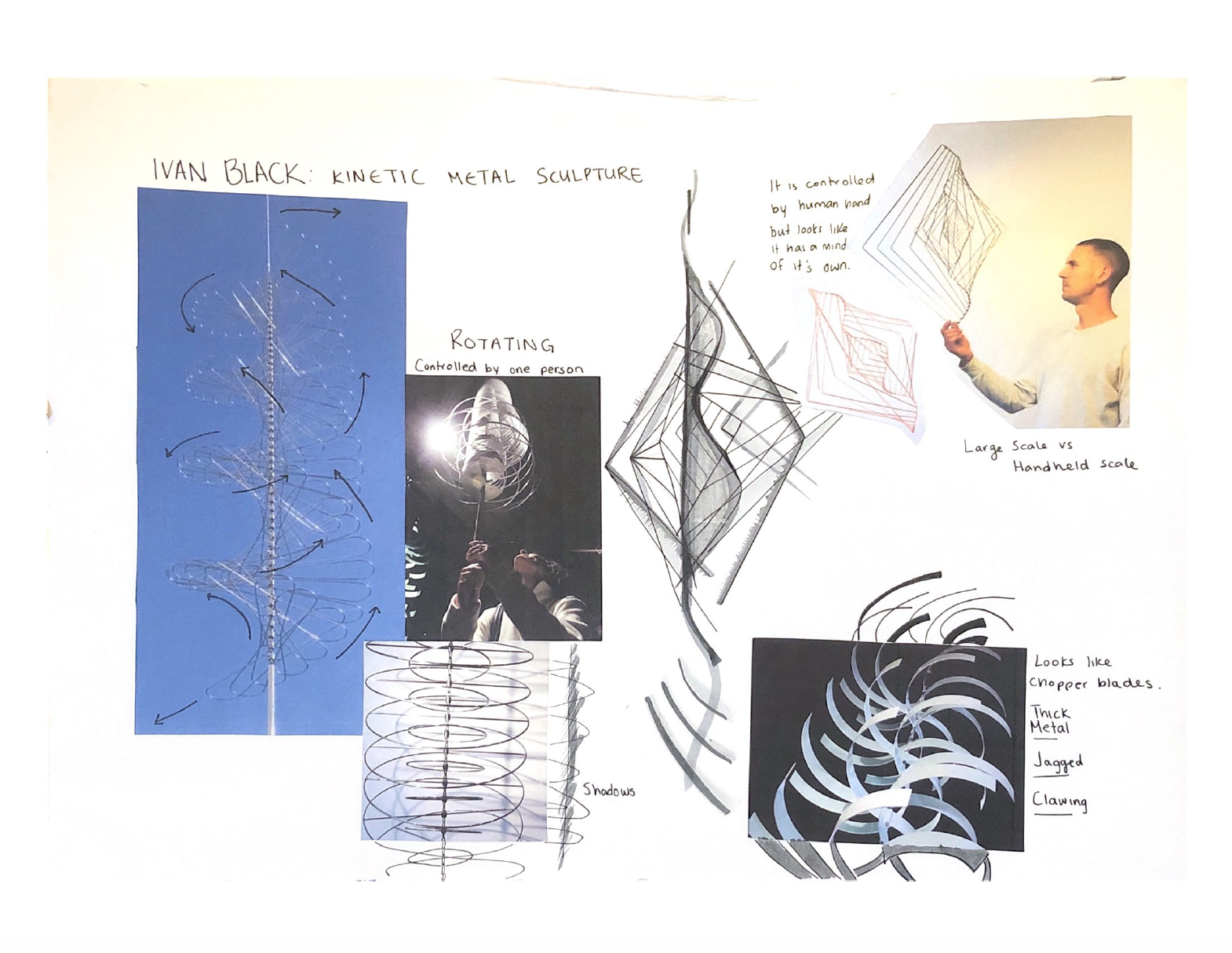
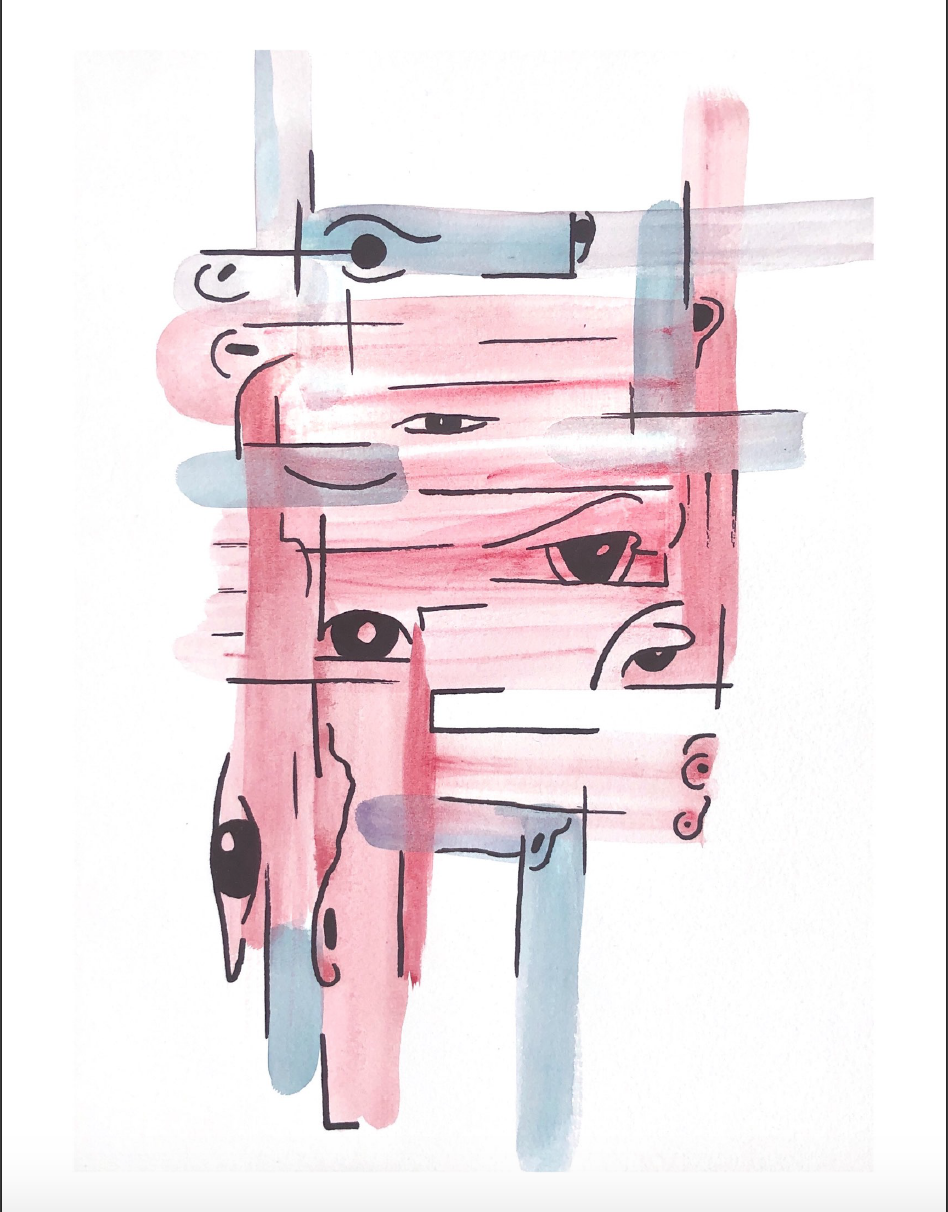
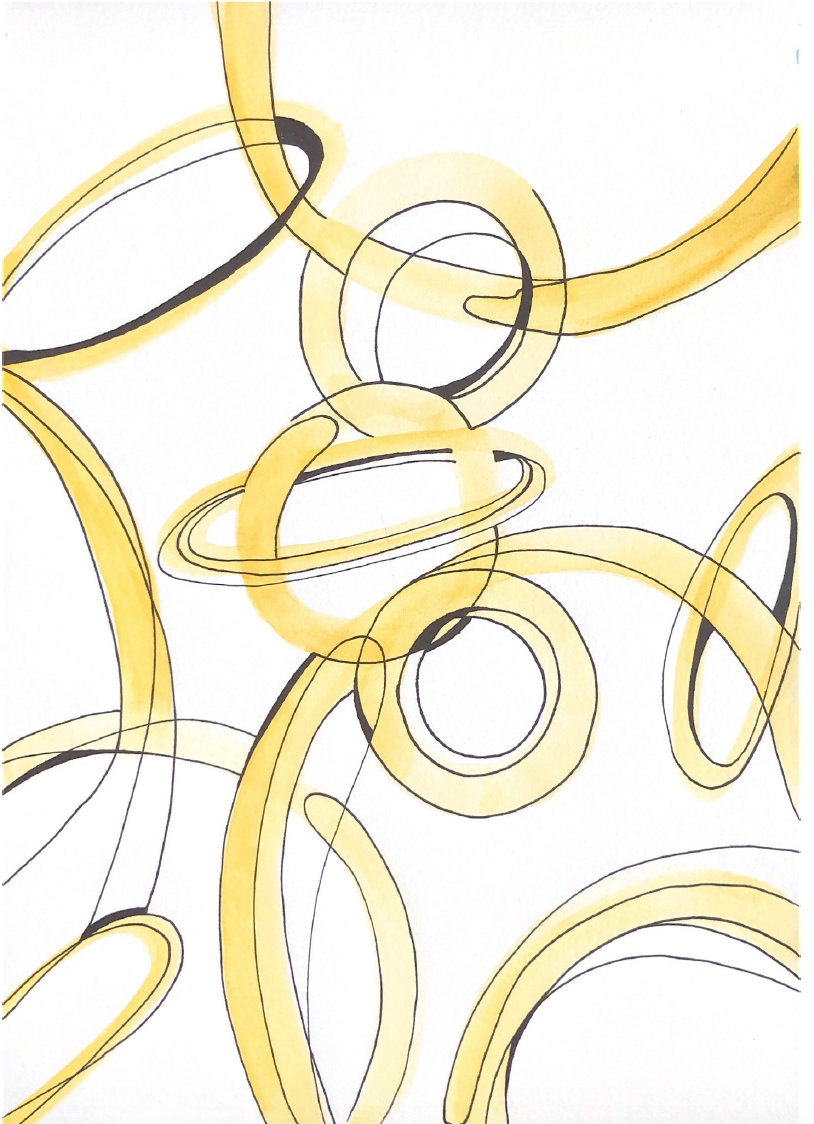


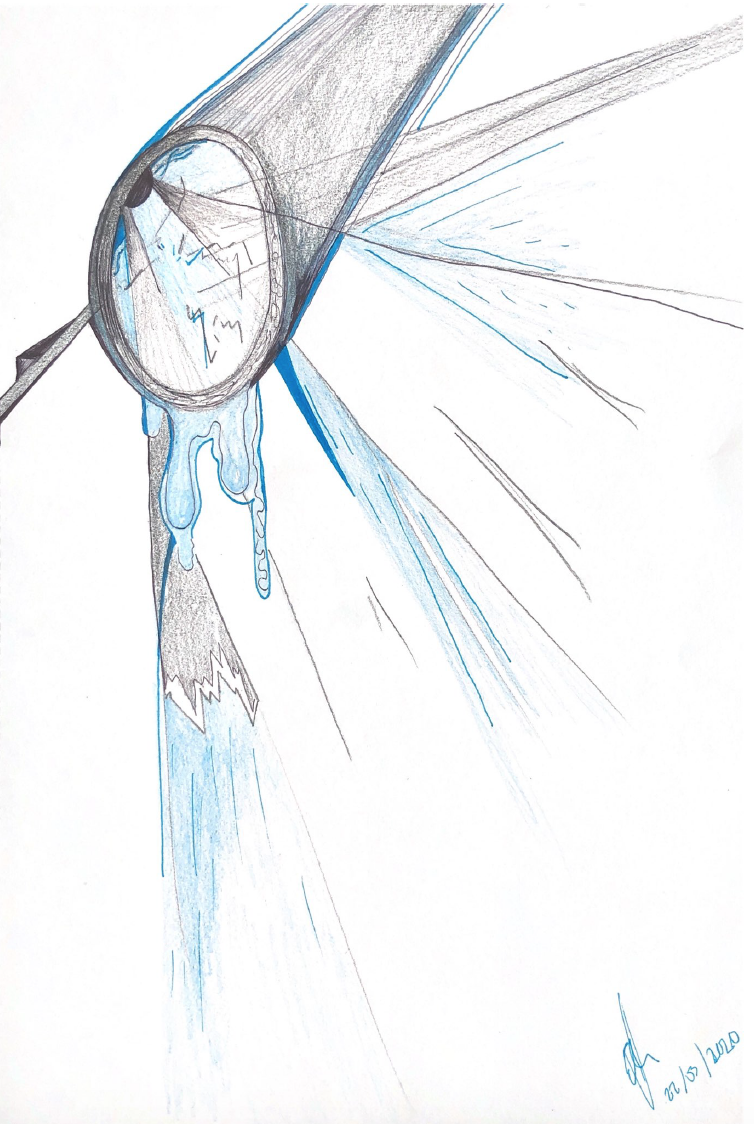

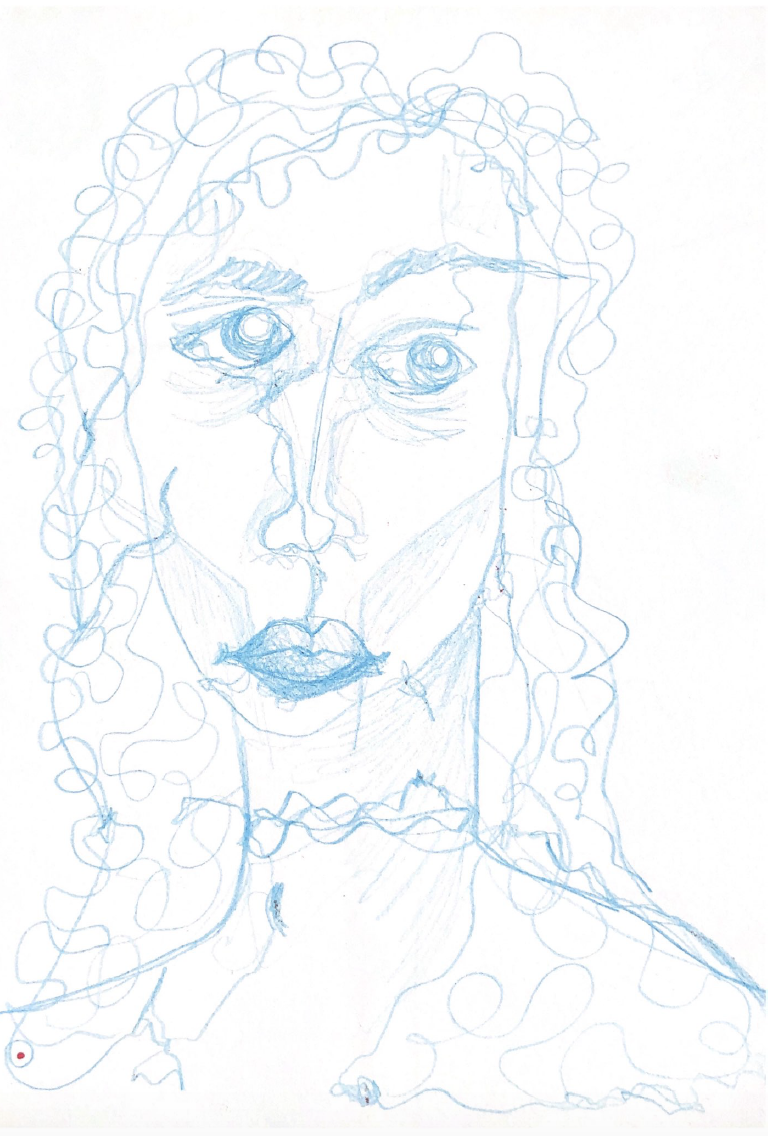


The performances that inspired this included:
-Christopher Haas: Triangle of Squinches
-Ockham’s Razor: Every Action...
-Damien Jalet & Sidi Larbi Charkaoui: Pelléas et Mélisande (set design by Marina Abramovic, costumes by Iris van Herpen)
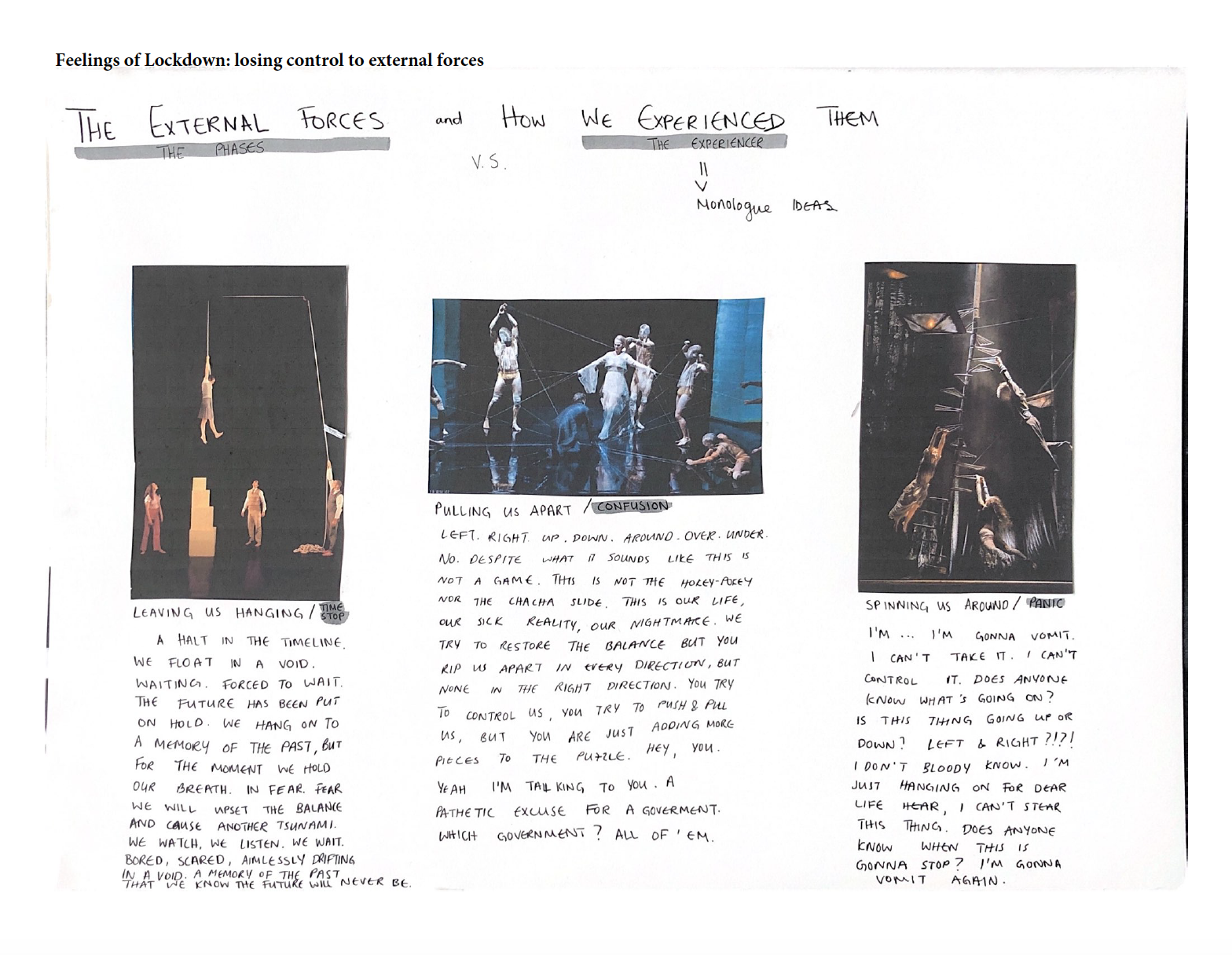
We both agreed to run with the visual of a cycle as our starting point that could inform the narrative, set, costumes, and movement. Looking at my above research, a continuous line of thought was the interaction between the space and the performer. The space was a performer of it’s own and had a kinetic presence within the cast. For example, Le Mouvement De L’air by Adrien M. & Claire B. which featured a tornado of interactive projections surrounding a dancer. (above, third from left). While Maya began dissecting the above research to create character profiles, I did visual research on cycles.


This research led me down the rabbit hole of kinetic sculptures. This was my first initial idea for realising my concept of an interactive space/the space being it’s own performer.
I firstly looked at Paul Friedlander, who creates installations of oscillating waves using light & color. This intrigued me because of the ability to create multiple shapes and morph between them through the mathematival algorithms & the color patterns. However, I knew I could not achieve this because of the technology and science required.
I then discovered Ivan Black who creates kinetic metal sculptures that are operated by hand but also look like they are moving independently. While a person had to trigger the movement, the sculpture is able to sustain a movement pattern similar to a kinetic wind sculpture. But, I was specifically drawn to the idea that the movement pattern could be manipulated by hand. This interaction became the starting point for the set design that would inform the devising process.
NEXT: CREATIVE PROCESS︎︎︎
CREATIVE PROCESS
To begin devising the performance, Maya and I started by creating character profiles. We knew we would have two subsets of characters:
In this process, we brainstormed our personal experiences (unique & mutual) throughout lockdown and grouped them into categories of overarching emtoins. For example: getting stuck abroad, pets passing away, family members/friends getting ill, picking up new creative hobbies, educating ourselves (re: black lives matter), online learning, etc.We broke down these experiences based off how they made us feel in the moment. We narrowed it to:
PANIC: the fear of uncertainty.
CONFUSION: losing all control over our circumstances & lifestyles.
DEATH/GRIEF: the death of a loved one (friend, family, pet), but also greiving the loss of our lifestile and our routine.
TIMESTOP: the extended period of lockdown which allowed us to explore new hobbies, learn new skills, but also being trapped within a form of unproductivity as everyday turned into the same trapped repetition.
REGROWTH: the aspiritation and optimism that we would come out stronger as individuals, communities, and socieities after this.
It is important to note that we did not want this piece to be a complaint letter about being in lockdown nor a woe-is-me sulking about our first-world troubles. Our conceptual take was to investigate the psyche in lockdown as a self-reflection for audience members and ourselves in the making process. It was very important for us to include the emotional phase of REGROWTH. Although we struggled with his immensly because at the time of developping our ideas, we were in the second-wave lockdown and the university had shut down again. This turned into a productive exercise for us to remain optimistic and productive.
Our fifth character is The Experiencer, the individual that represents us all being stuck in the cycle of emotional phases.
I first created moodboards for each character:
![]()
![]()
![]()
![]()
![]()
![]()
Now that we had confirmed the characters: CONFUSION, GRIEF, TIMESTOP, and REGROWTH, I went back and did some more visual research to develop my costume designs. This included: Issey Miyake, Iris Van Herpen, Antony Gormley, Oskar Schlemmer, Alexander McQueen. Below are some of my costume moodboards and some initial response sketches.
PANIC: the fear of uncertainty.
CONFUSION: losing all control over our circumstances & lifestyles.
DEATH/GRIEF: the death of a loved one (friend, family, pet), but also greiving the loss of our lifestile and our routine.
TIMESTOP: the extended period of lockdown which allowed us to explore new hobbies, learn new skills, but also being trapped within a form of unproductivity as everyday turned into the same trapped repetition.
REGROWTH: the aspiritation and optimism that we would come out stronger as individuals, communities, and socieities after this.
It is important to note that we did not want this piece to be a complaint letter about being in lockdown nor a woe-is-me sulking about our first-world troubles. Our conceptual take was to investigate the psyche in lockdown as a self-reflection for audience members and ourselves in the making process. It was very important for us to include the emotional phase of REGROWTH. Although we struggled with his immensly because at the time of developping our ideas, we were in the second-wave lockdown and the university had shut down again. This turned into a productive exercise for us to remain optimistic and productive.
Our fifth character is The Experiencer, the individual that represents us all being stuck in the cycle of emotional phases.
I first created moodboards for each character:
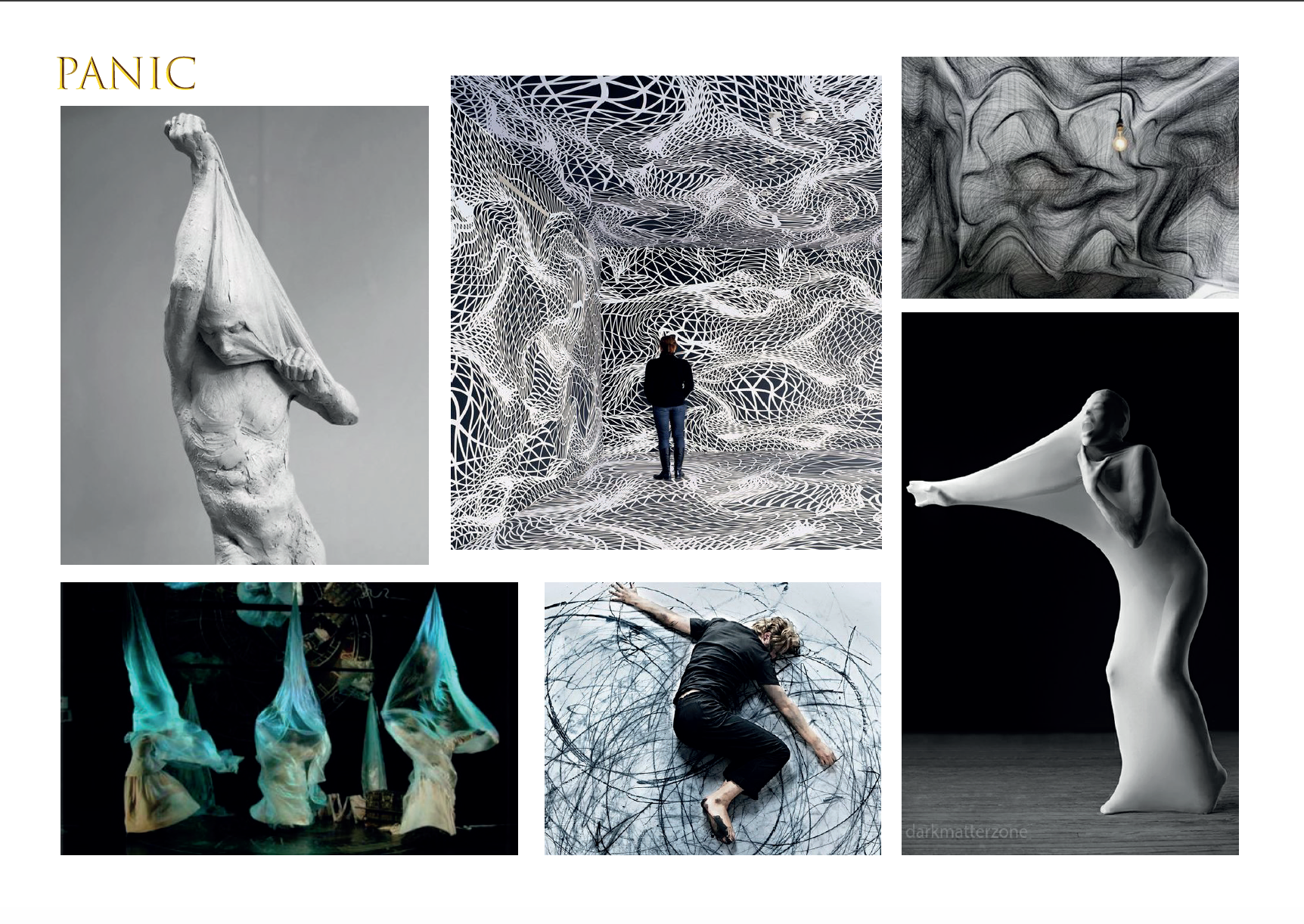


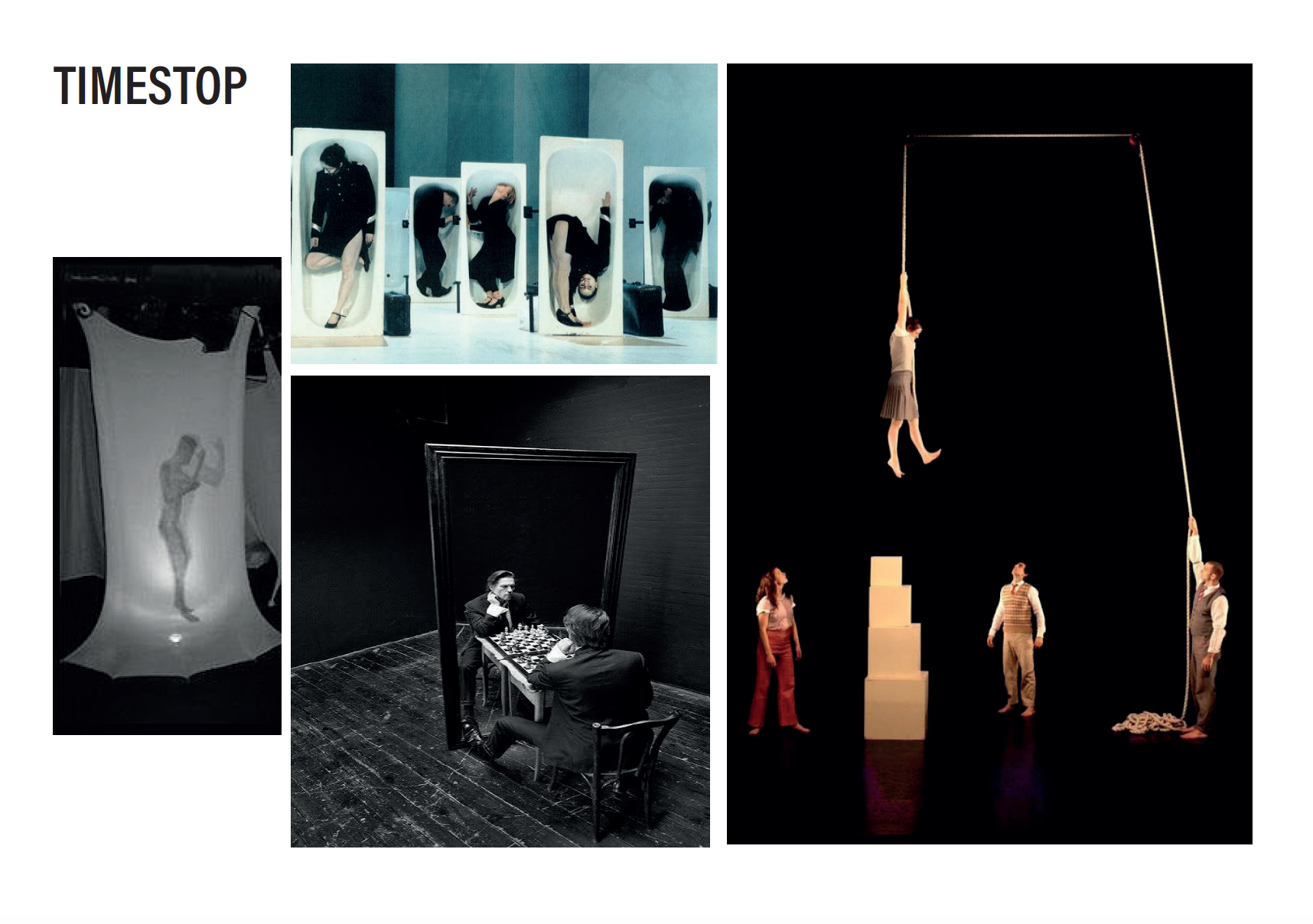

We also set out with creating a brief for the structure of the piece, which we called The Cycle. This was a loose guide to help us communicate the idea with the collaboraters we were pitching it to. We knew this was bound to change once the other collaborators inserted their experiences into the devising process.
I wanted to make it clear that this process and narrative were based entirely on interplay and interaction. By allowing the process to be reactionary, I hoped that it would be an effective mode of working to hone in on how this was based on ongoing lived experiences. We were not yet out of lockdown and making this in hindsight. We were making this while still reacting to the uncertain circumstances around us.
At this point in the process we also looked back on the visual research and decided to take the multi-media approach in order to create a distinct contrast in the visual dramaturgy between the Emotional Phase characters and The Experiencer. The Emotional Phases would appear as projections to highlight that they were not tangible elements The Experiencer has control over. This was also to play around with scale in the physical vs digital presence.
On another note, the decision to have the projections was also for two practical reasons: to limit our cast number for safety of covid bubbles & in the case that we would not be able to stage the performance, we could at least have some pre-recorded content and turn it into a film.
We also wanted to make the characters more distinct. We decided that the Panic phase was almost a hybrid of grief & confusion, so we abandoned that character.
I wanted to make it clear that this process and narrative were based entirely on interplay and interaction. By allowing the process to be reactionary, I hoped that it would be an effective mode of working to hone in on how this was based on ongoing lived experiences. We were not yet out of lockdown and making this in hindsight. We were making this while still reacting to the uncertain circumstances around us.
At this point in the process we also looked back on the visual research and decided to take the multi-media approach in order to create a distinct contrast in the visual dramaturgy between the Emotional Phase characters and The Experiencer. The Emotional Phases would appear as projections to highlight that they were not tangible elements The Experiencer has control over. This was also to play around with scale in the physical vs digital presence.
On another note, the decision to have the projections was also for two practical reasons: to limit our cast number for safety of covid bubbles & in the case that we would not be able to stage the performance, we could at least have some pre-recorded content and turn it into a film.
We also wanted to make the characters more distinct. We decided that the Panic phase was almost a hybrid of grief & confusion, so we abandoned that character.

COSTUME DESIGN
Now that we had confirmed the characters: CONFUSION, GRIEF, TIMESTOP, and REGROWTH, I went back and did some more visual research to develop my costume designs. This included: Issey Miyake, Iris Van Herpen, Antony Gormley, Oskar Schlemmer, Alexander McQueen. Below are some of my costume moodboards and some initial response sketches.
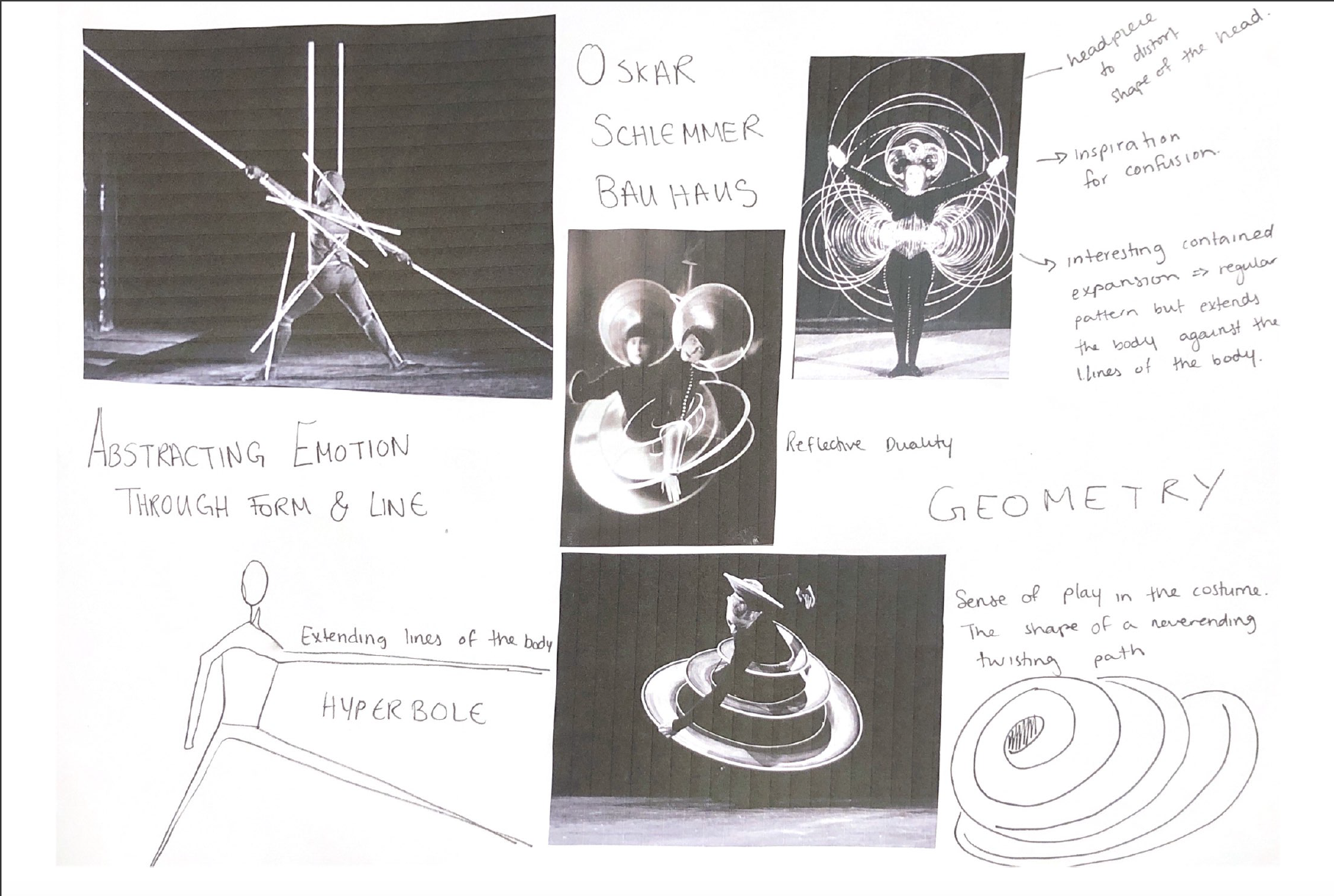


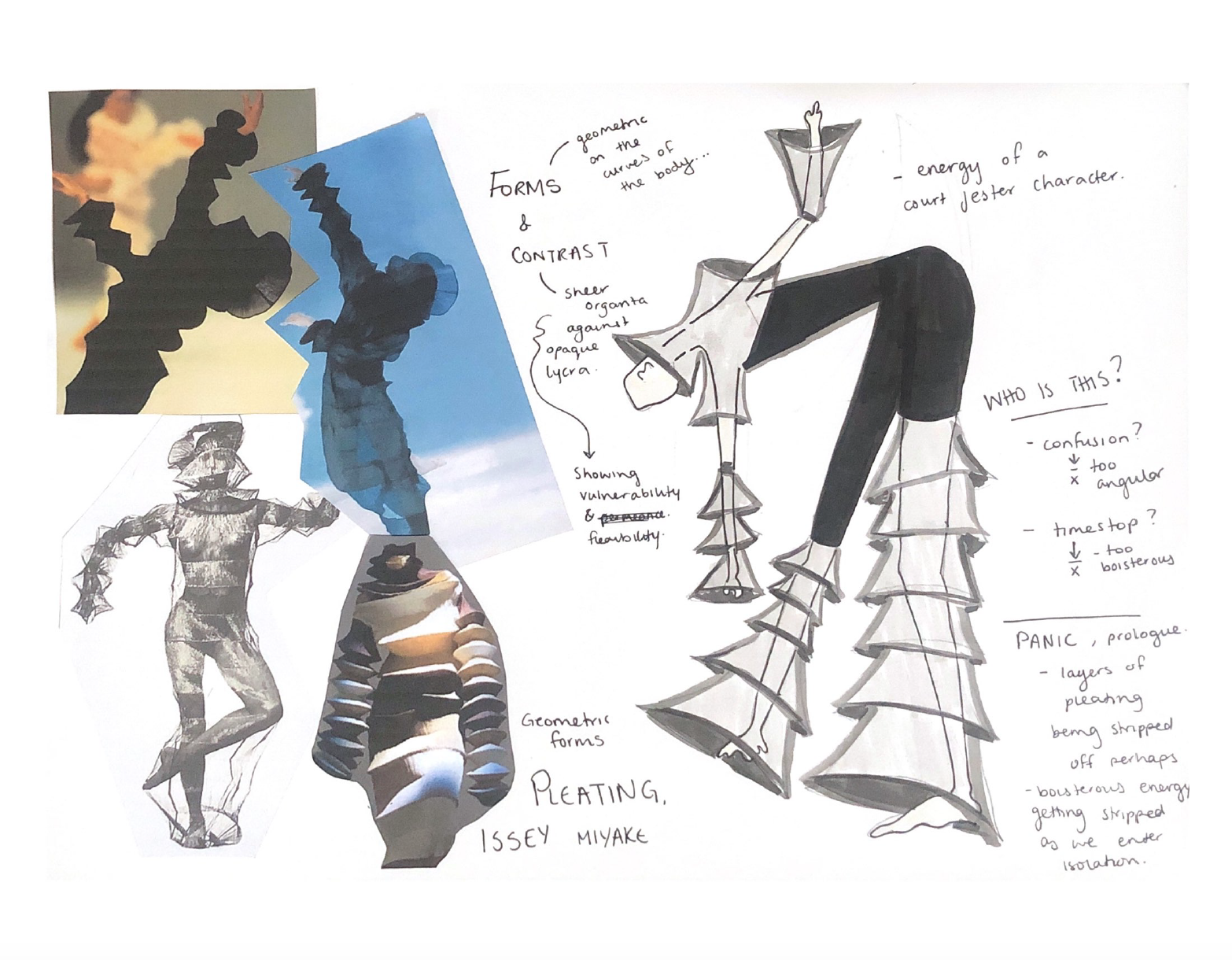
Upon first instinct, most of the images I was attracted to for CONFUSION, DEATH/GRIEF, and TIMESTOP, were black & white which was actually influenced by my earlier research on Gilbert Garcin. I felt that compositionally, the starkness was evokative and direct since these characters would be filmed as projection content. I also wanted to visualise a contrast between those three more “negative” characters and our ultimate journey to REGROWTH to make the shift to optimism more profound and visually prominent.
In hindsight, I wish I had done more making experimentation, but I was stuck abroad and did not have much access to my materials or space, so I experimented through drawing only. However, I was able to do a small crochet sample which I was happy with.
When I began sketching costume ideas, we hit a snag in the dramaturgy. I had been interpreting the character as DEATH while Maya had been interpreting it as GRIEF. So in my initial sketch, it was a visual depiction of a death to show the pain. But we discussed and realised that we were going for GRIEF because it evoked the weight of the emotion much more powerfully. It was a more transferrable way of communicating the pain in that feeling.
Before beginning a process with the choreographer, I wanted to have the costume designs ready in order for their movement to be a reaction to the designs. This was always intended to be a design-led process, so I felt confident when first pitching the idea to Isaac (Zac) Irvine, for him to be aware of the potential restrictions of the body. Bringing Zac into the process was ideal for the design-led devising approach because he works improvisationally.
In hindsight, I wish I had done more making experimentation, but I was stuck abroad and did not have much access to my materials or space, so I experimented through drawing only. However, I was able to do a small crochet sample which I was happy with.
When I began sketching costume ideas, we hit a snag in the dramaturgy. I had been interpreting the character as DEATH while Maya had been interpreting it as GRIEF. So in my initial sketch, it was a visual depiction of a death to show the pain. But we discussed and realised that we were going for GRIEF because it evoked the weight of the emotion much more powerfully. It was a more transferrable way of communicating the pain in that feeling.
Before beginning a process with the choreographer, I wanted to have the costume designs ready in order for their movement to be a reaction to the designs. This was always intended to be a design-led process, so I felt confident when first pitching the idea to Isaac (Zac) Irvine, for him to be aware of the potential restrictions of the body. Bringing Zac into the process was ideal for the design-led devising approach because he works improvisationally.
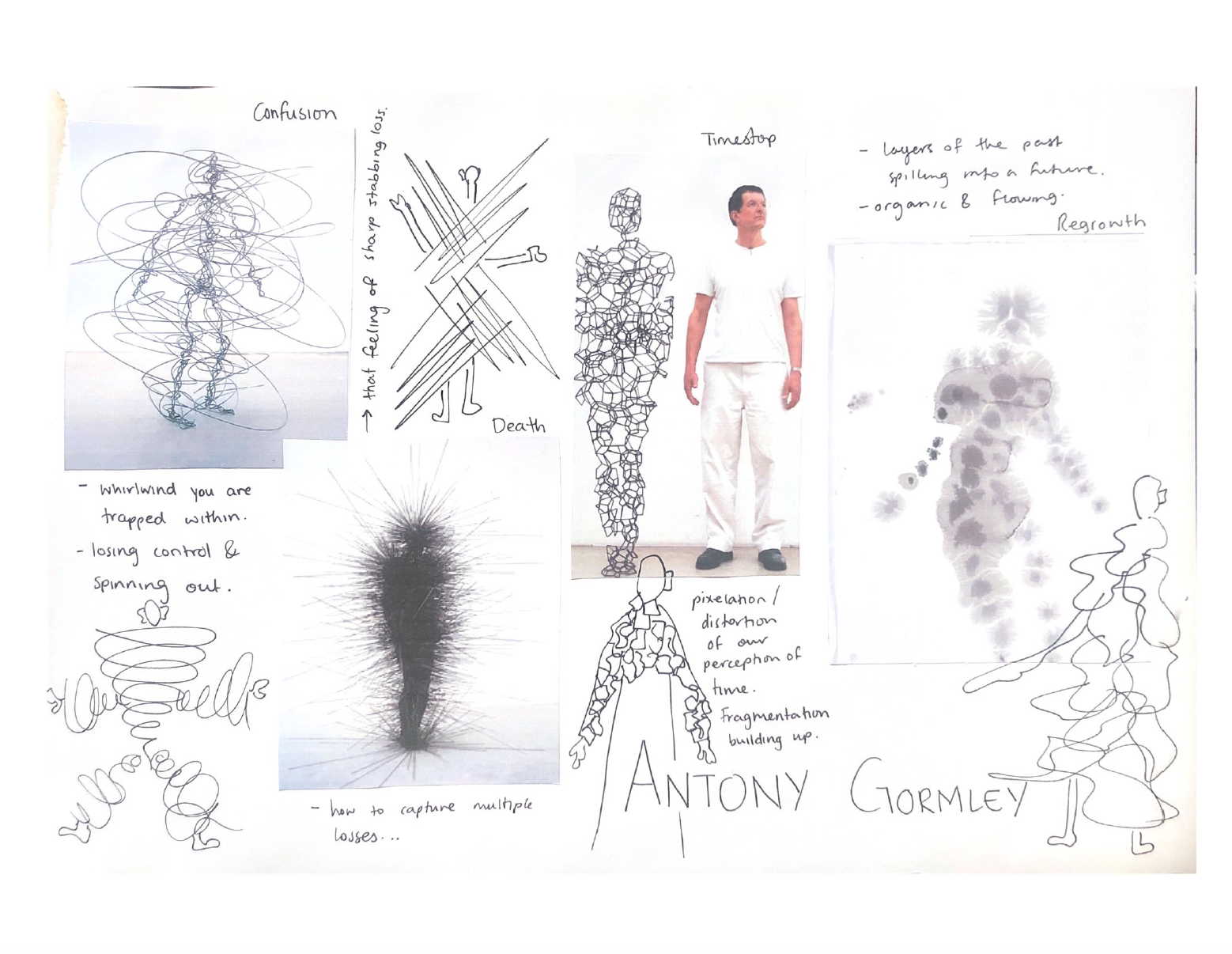
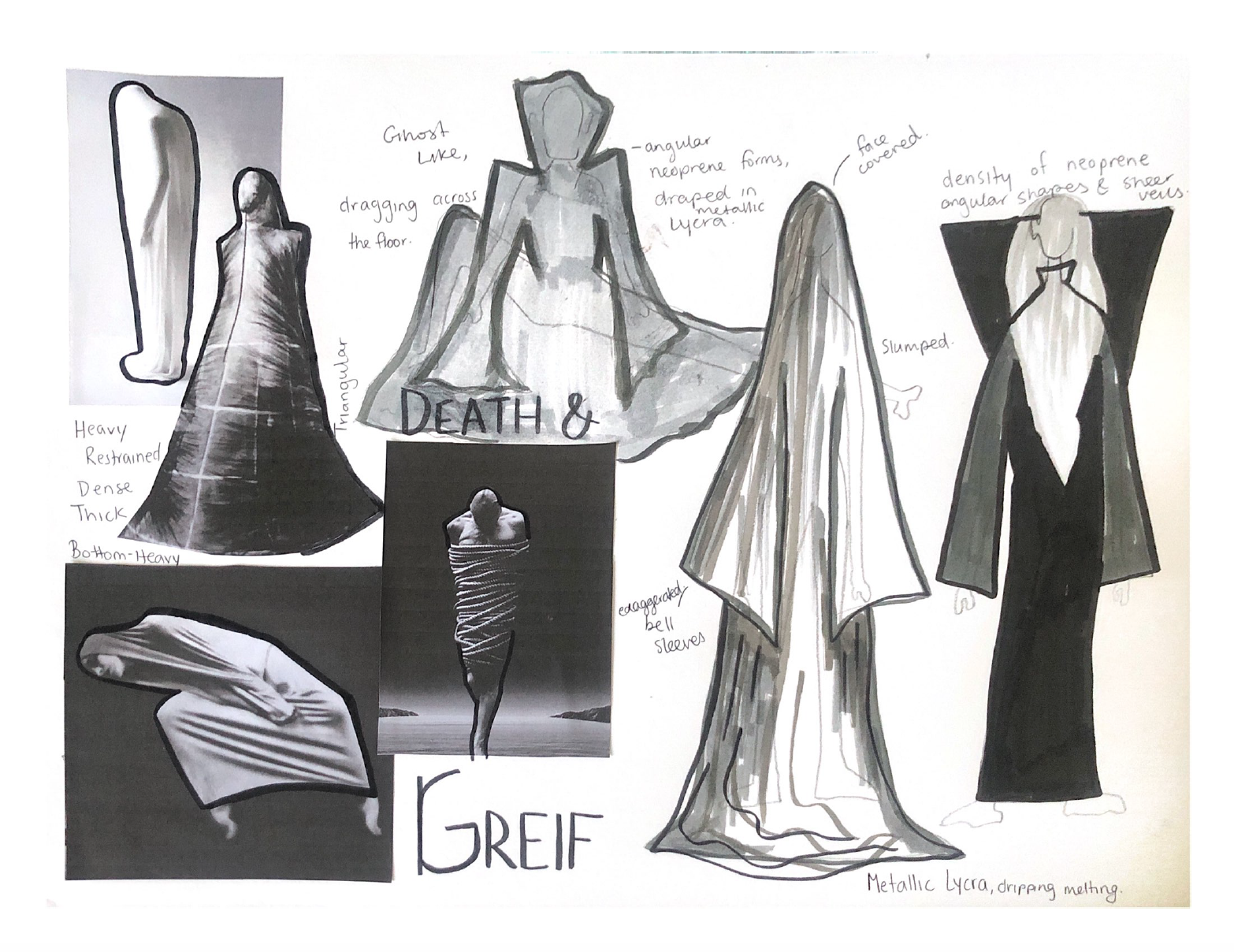

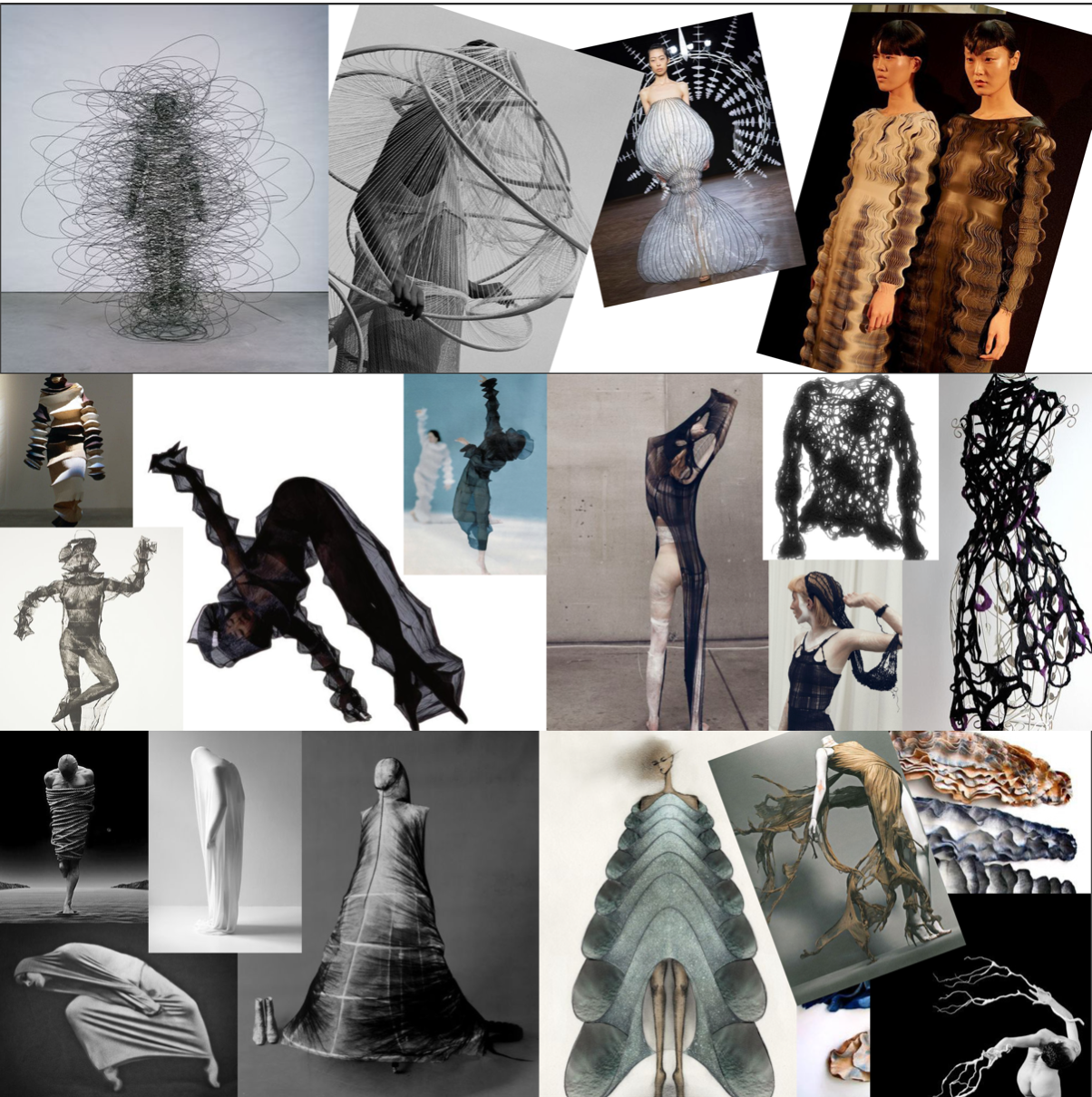

In the designs, I also created a distinction between CONFUSION, DEATH/GRIEF, and TIMESTOP all having forms of restriction to the body versus REGROWTH accentuating the flow of the body.
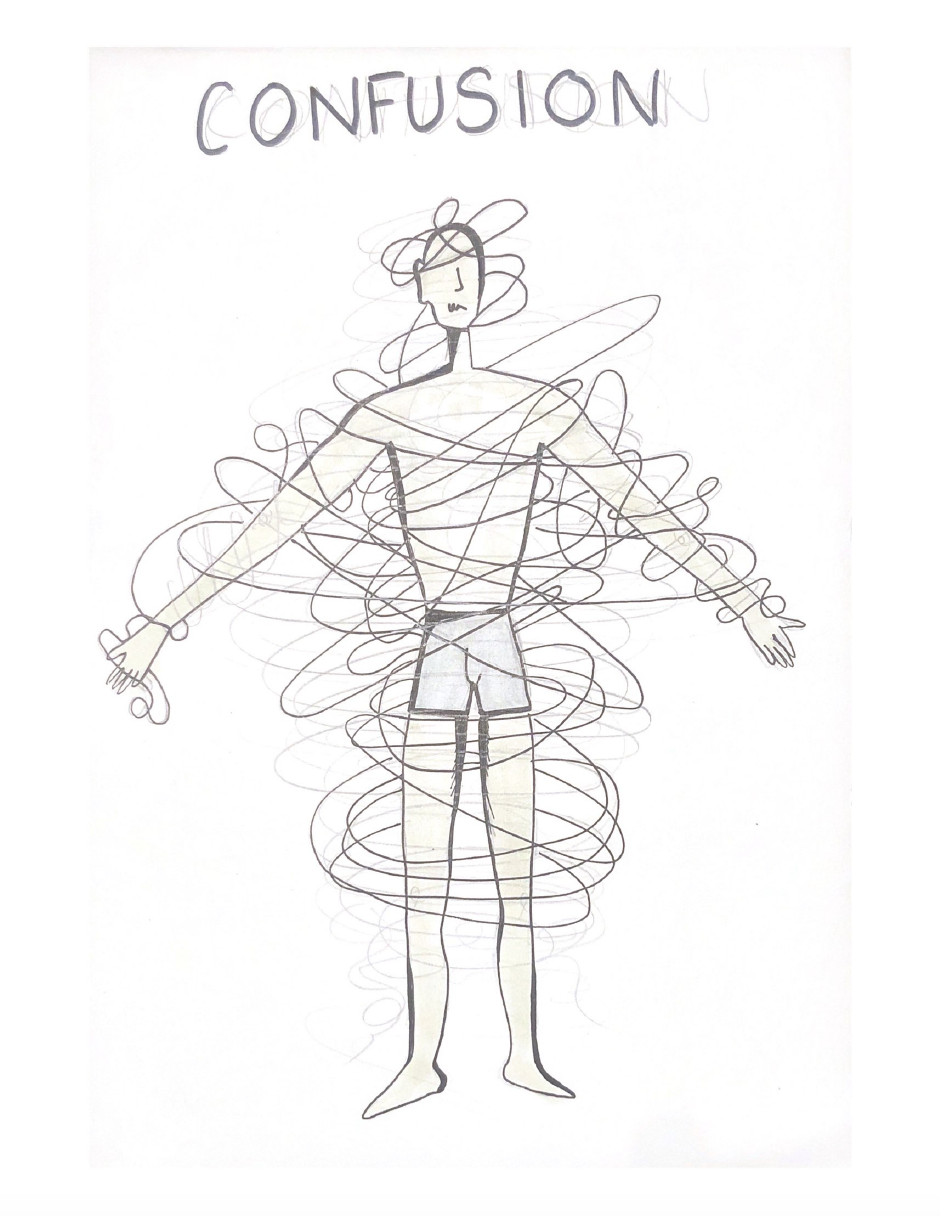
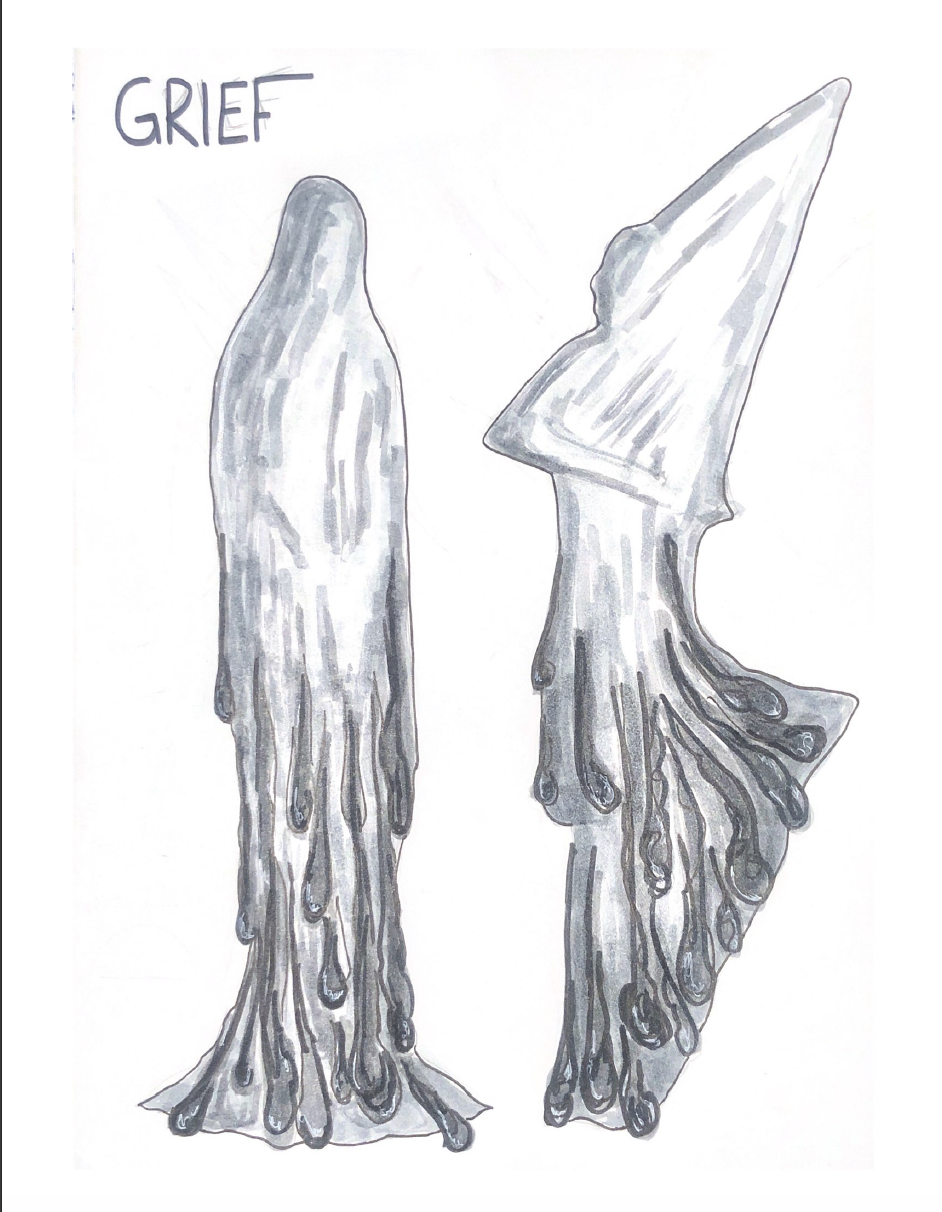


Confusion is inspired by Antony Gormley’s wire scultpures.
Grief is inspired by Frieder Grindler’s candle composition.
Timestop is inspired by my personal lockdown hobby, crochet, & fragmentation.
Regrowth is inspired by textural layering to show how we evolve from the accumulated past.
SPATIAL DESIGN
It was really difficult to develop the set design because I could not experiment in a space, and I felt that I needed more elements of the choreography & sound design to properly start designing the space. Now that I had hit a wall, my priority was to begin collaborating on the choreography & sound. Kristina Kapilin joined the team. I wanted to work with Kristina because from what I heard of her compositions, they are layered soundscapes which create an atmosphere. This was vital in getting Zac to respond through movement and for me to begin imagining how the space would come to life. In the collaboration with Kristina, she worked from the character profiles to create distinct soundtracks for each emotional phase, while composing them in a way where they could be layered to create The Cycle. In fact, her sound design compositions actually were the deciding factor for the structure of the piece because of how she imagined they flowed together.
As we started to rehearse some movement ideas, this inspired my exploration for the spatial design. I picked up from where I left off in my research on kinetic sculptures. I was inspired by Olafur Eliasson’s artwork to create a whirlwind shape with kaleidoscopic effect. I made a sketch model from paper,tape, markers, and a torch to experiement with how the light & forms could transform the atmosphere.
![]()

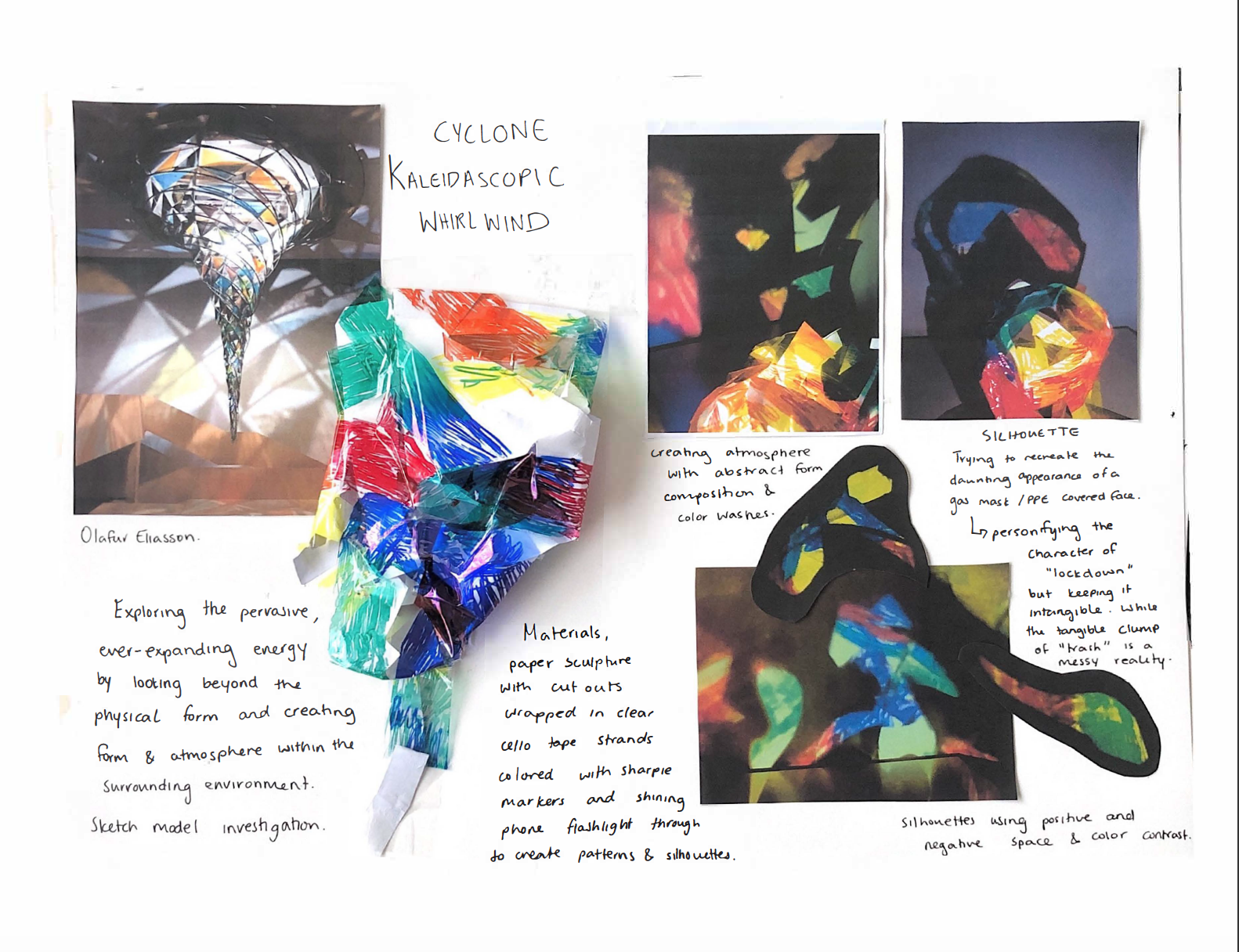
I also experiemnted with creating a sketch model using found objects and digitally manipulating it to create different planes, refractions, and layering of a space.
While these brief ideas were helpful for getting some hands-on experimentation, they did not inspire me further because I felt they were too distracting and convoluted for the visual dramaturgy.
Upon reflection, I realised that we were moving towards multi-media and the projection being the focal point of our visual dramaturgy.
So I wanted to focus my research towards that. I began looking at how to create multiple layers in a space & research through drawing.

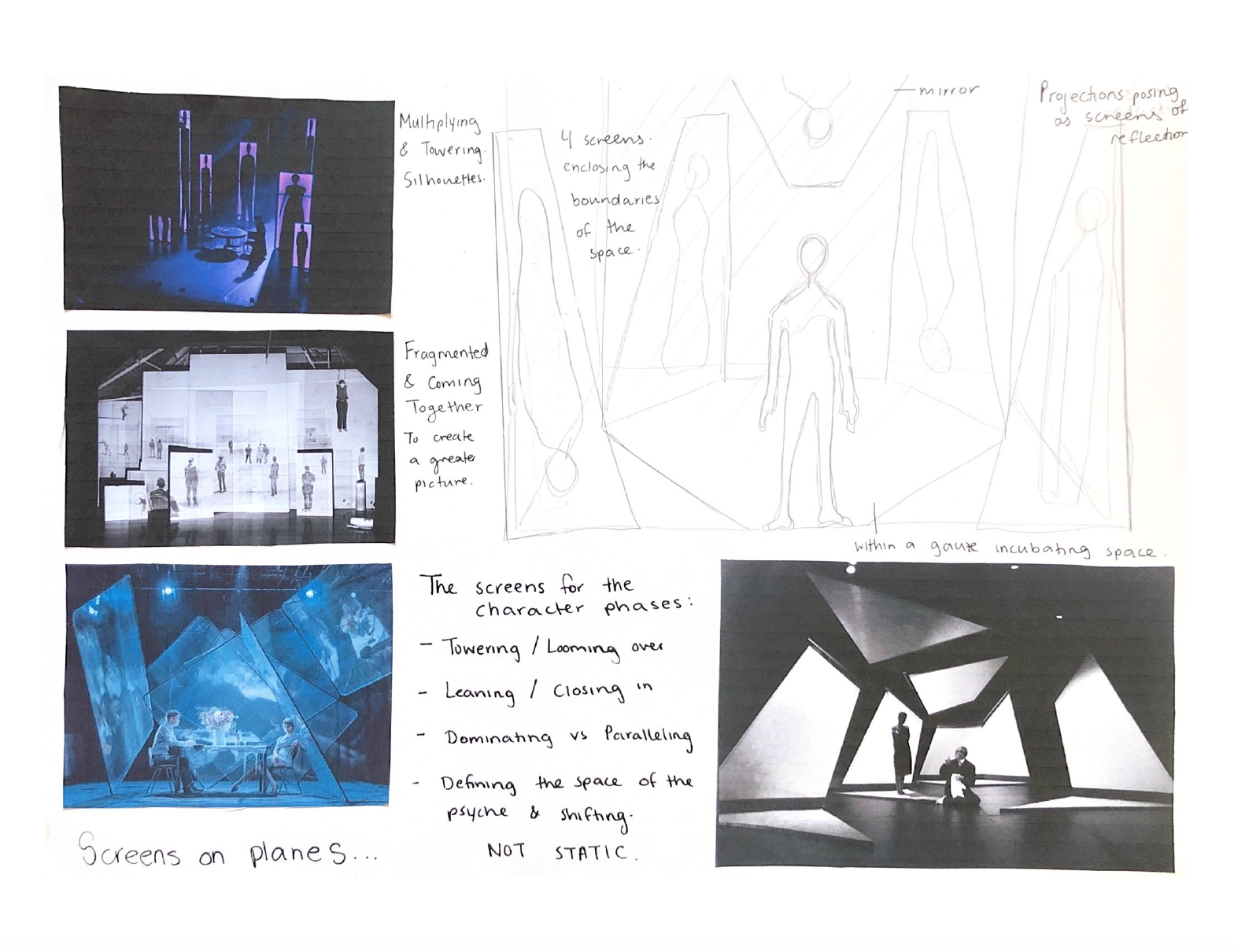
I was also interested in visualising the isolation we experienced in lockdown by creating a space within a space that encapsulated The Experiencer while having the projections external to that, but still infiltrating through the narrative & choreography.


My initial set design proposed a sheer fabric capsule which contained a rigged kinetic sculpture made of metal & gels to create a kaleidescope as it started turning. In the downstage, projection screens would fly in & out throughout The Cycle.
When discussing this idea with my collaborators, it was directly apparent that there was too much going on. Once the sound design was coming together and the choreography was being experimented with, I realised that some of the elements I was trying to address in my spatial design were already being dramaturgically answered in other forms. We definitely needed the projection screens, and visually the idea of the fabric tied in more effectively than the kinetic sculpture. Holistically, the sculpture felt like an after thought aesthetically. When discussing with my personal tutor, I also realised it was not feasible considering I had 4 costumes to make, projection mapping, Isadora programming.
I also wanted to experiment with simplifying the movement of the set. Rather than the screens flying in & out repeatedly, I was more intrigued by how the space could be alive. I did some experiments with the rigged fabric (which was an old cyc re-purposed from the Platform Theatre). Through playing in the space, I came to the effect of breathing using the cyc, which I thought would fit with the sound design and react to Zac’s choreography.

Additionally, I knew I would have limited budget (most of which was going to costume) so I wanted to rely on what I could find in the Platfrom Theatre to create my set. I also found a black sharkstooth gauze (which I had discovered the material during my Abu Ghraib project), and felt it would be the perfect addition as a threshold between the projections & the experiencer. I also found existing frames I could use as projection screens and fabrics that I could build my own screens with. This was my second set design proposal, which stuck. We reduced to 3 screens because of the throw of the projector being narrower than anticipated. This also solved a dramaturgical issue with REGROWTH’s appearance: we would have REGROWTH permeate all 3 screens taking over The Cycle.


NEXT: MAKING PROCESS︎︎︎
MAKING PROCESS
Just an overall recap of the making process across April & May. Important note: this focuses on the set & costume making process. Maya was in charge of the video design & animations, while I just programmed the projections, so I will not be able to cover the video design process.
COSTUME:
![]()
![]()
![]()
![]()
![]()
TIMESTOP: Crochet Sample ︎︎︎ Full Piece ︎︎︎ Fitting ︎︎︎ Rehearsal︎︎︎ Photoshoot

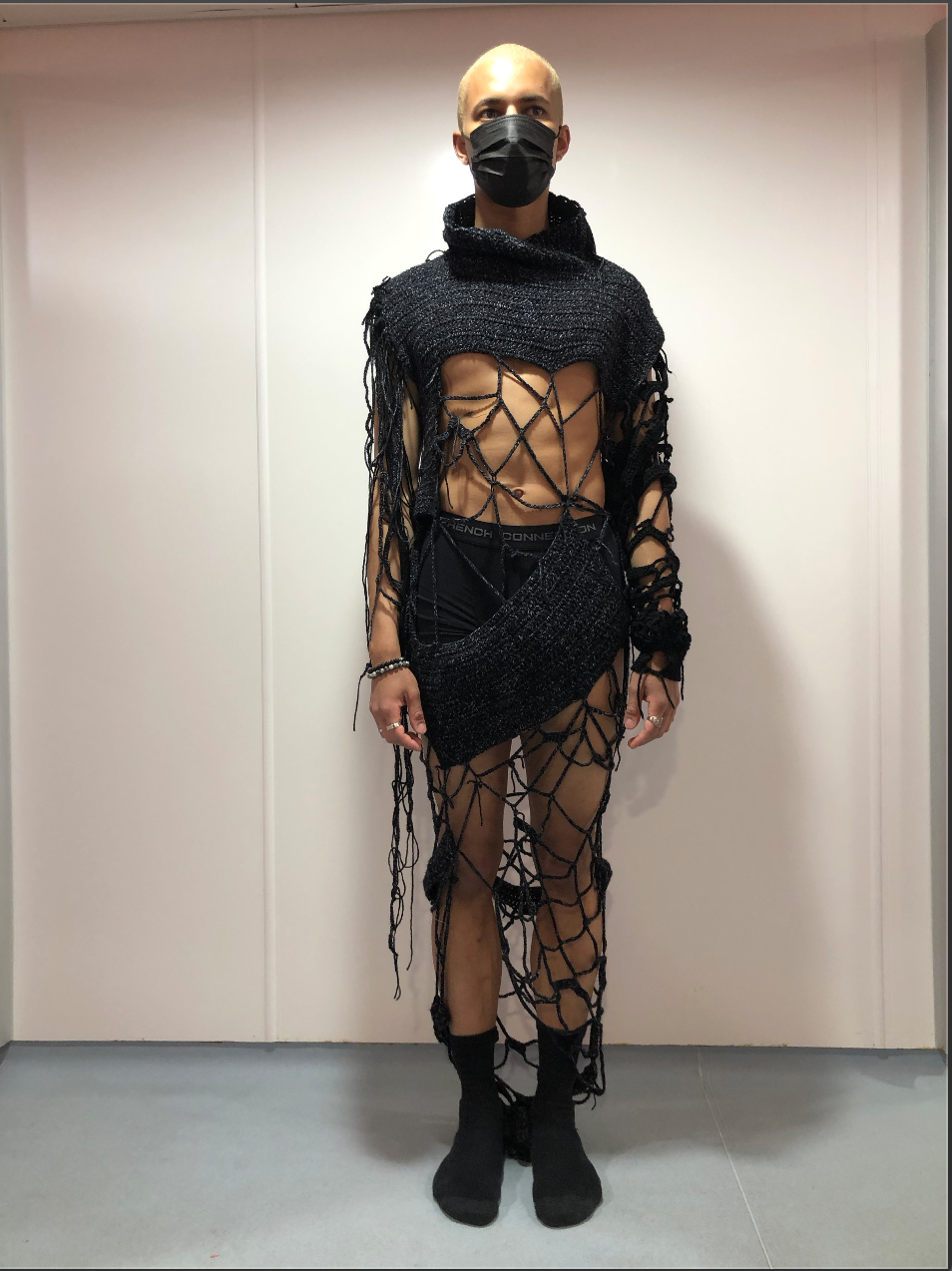


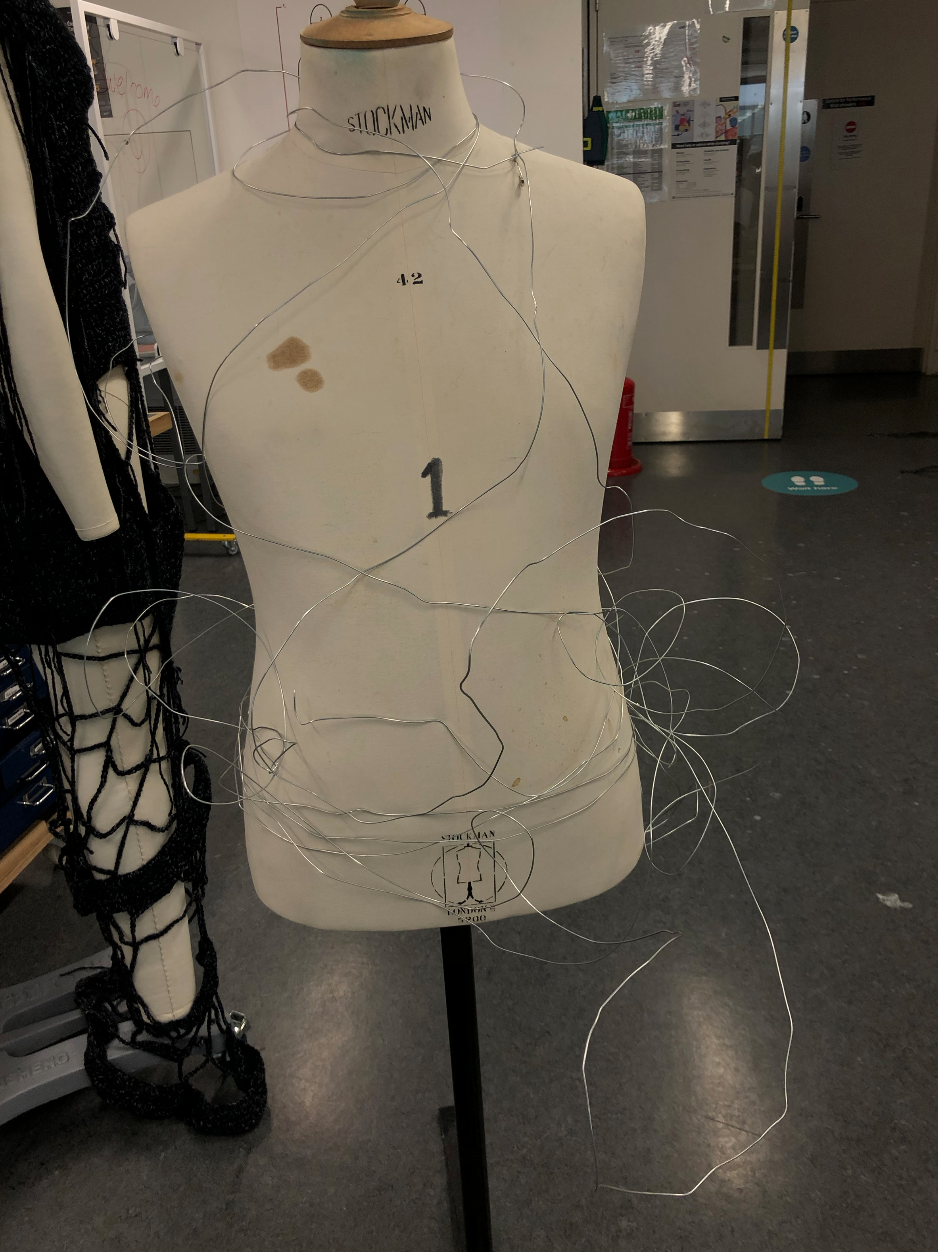


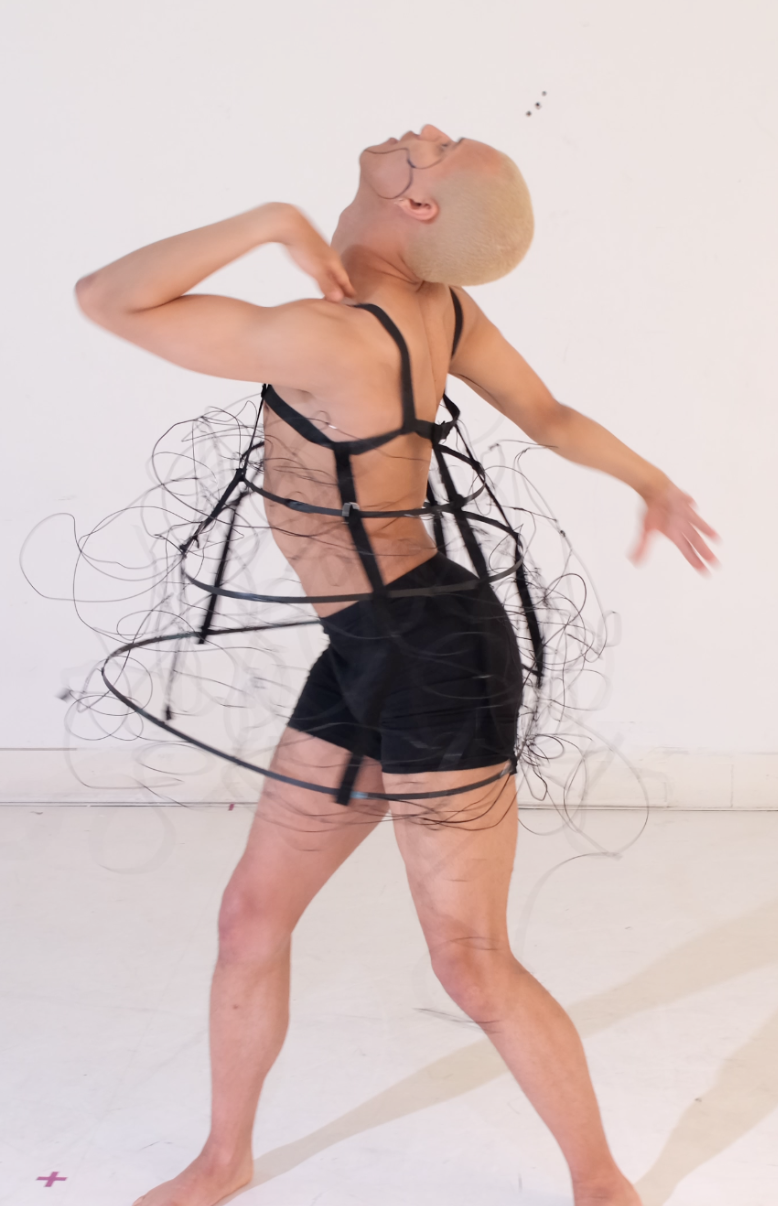
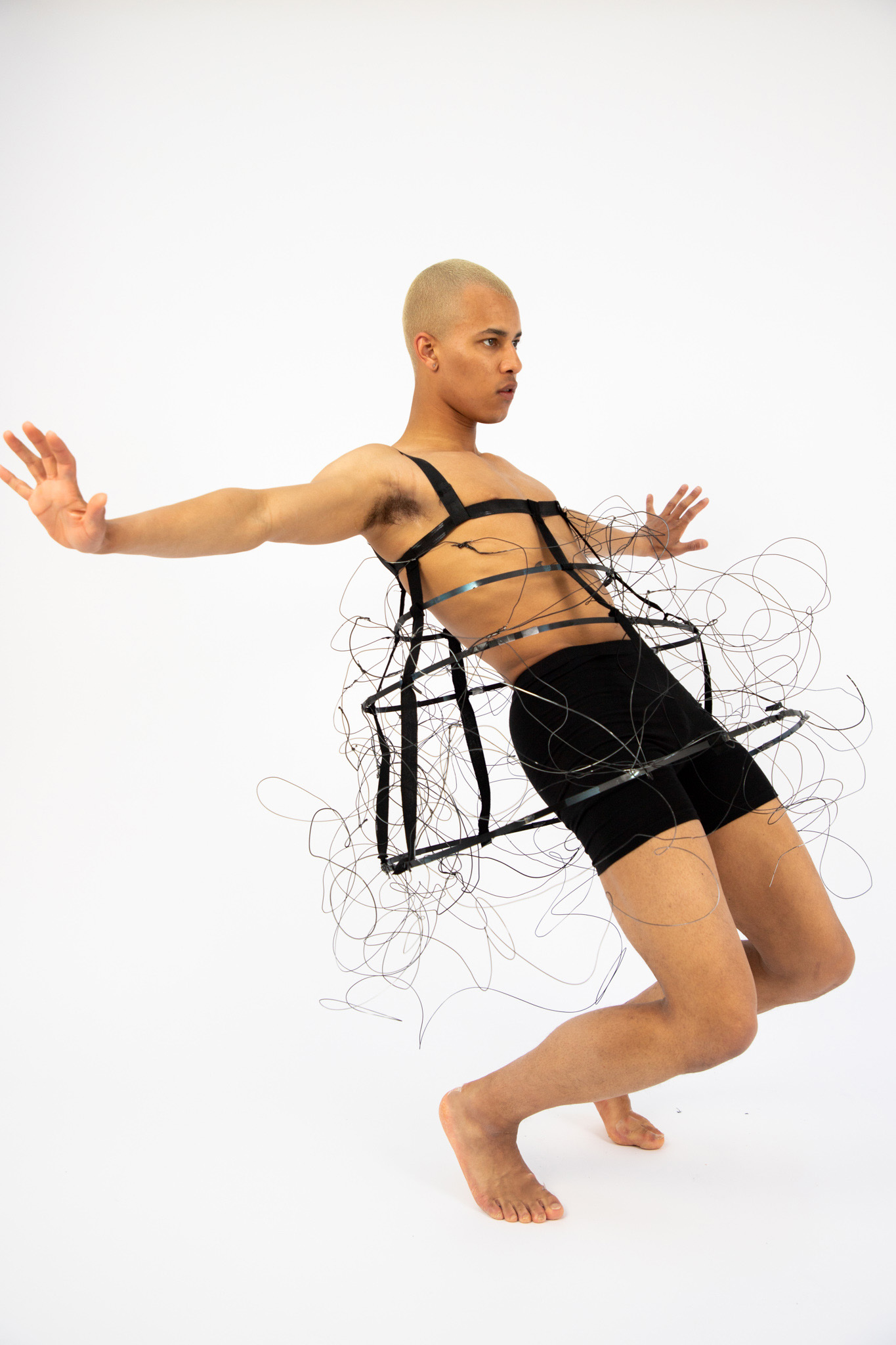
CONFUSION: Wire Sample ︎︎︎ Crinoline Build ︎︎︎ Fitting ︎︎︎ Rehearsal ︎︎︎ Photoshoot
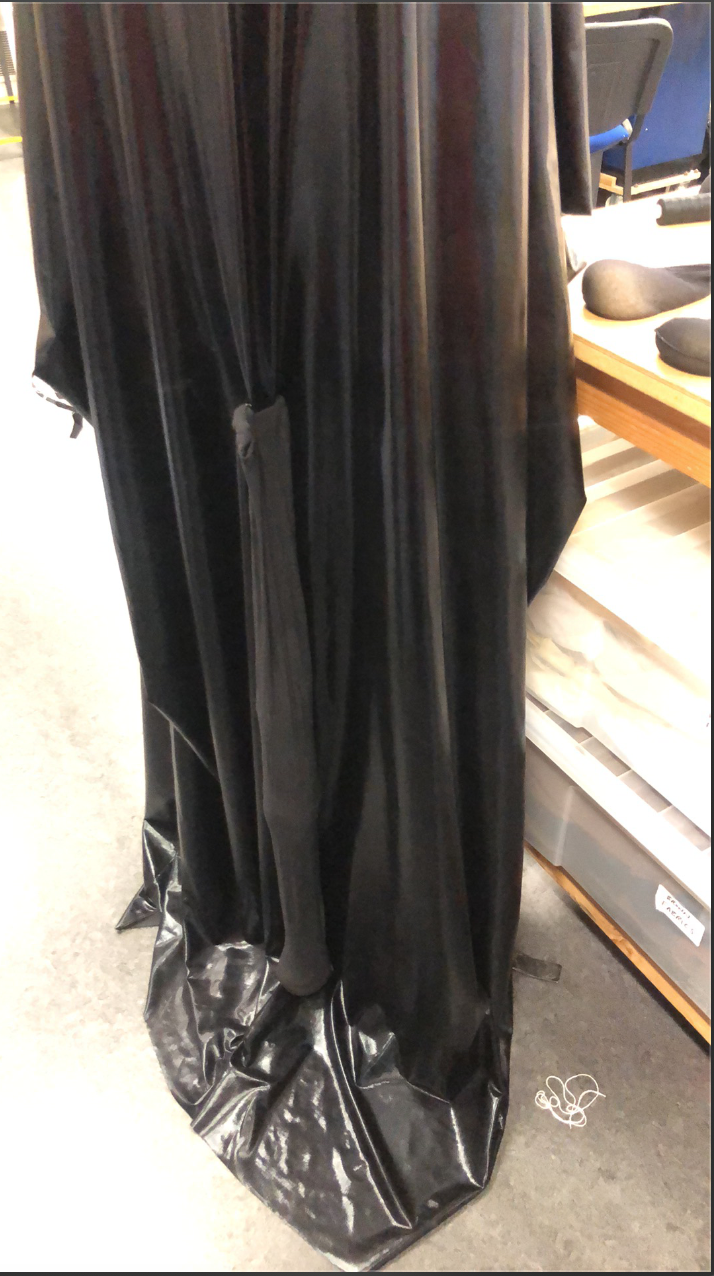

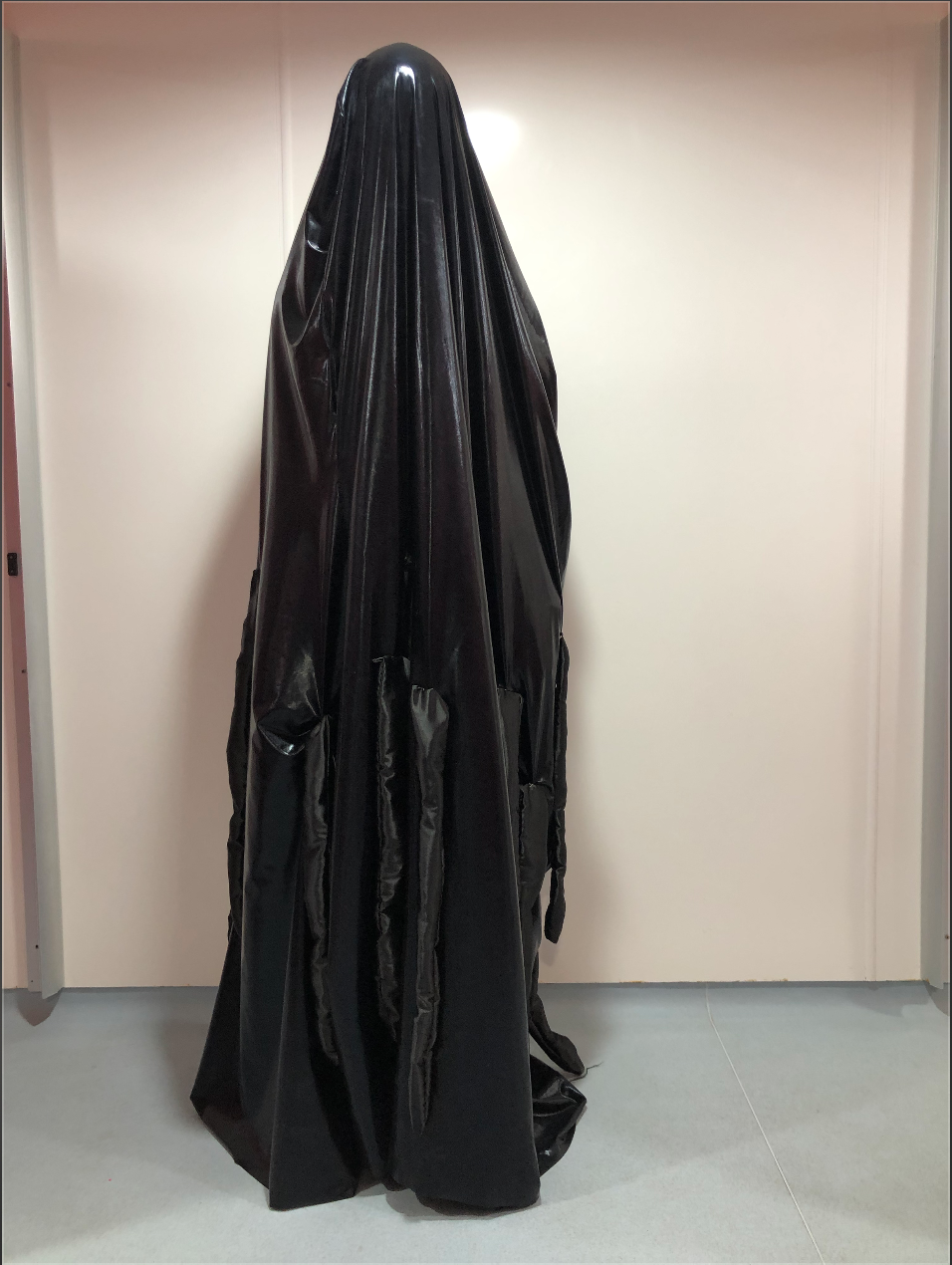

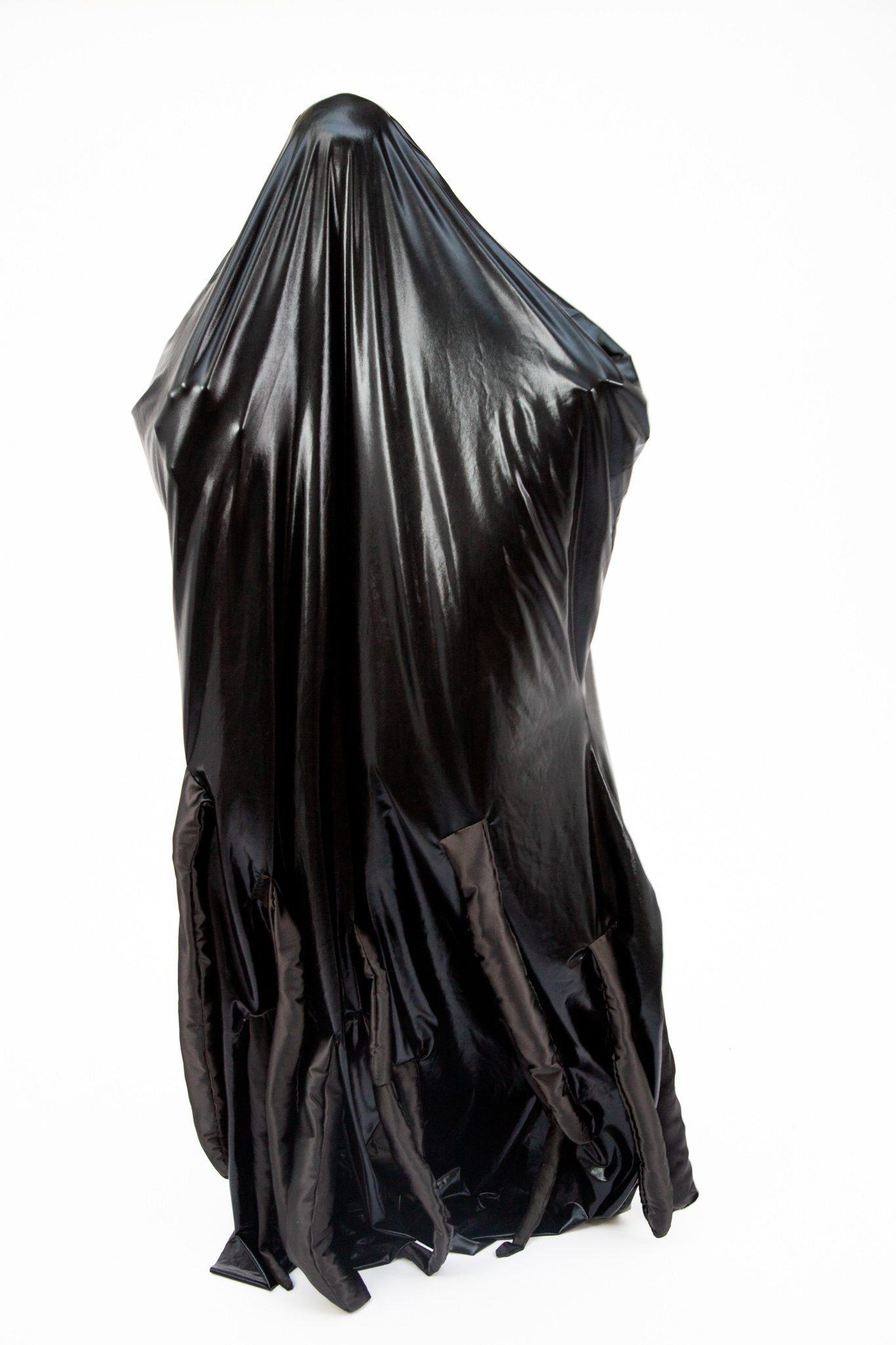
GRIEF: Tights w/ Rice Drip Sample ︎︎︎ Satin w/ Wadding Drip Sample ︎︎︎ Fitting ︎︎︎ Rehearsal ︎︎︎ Photoshoot
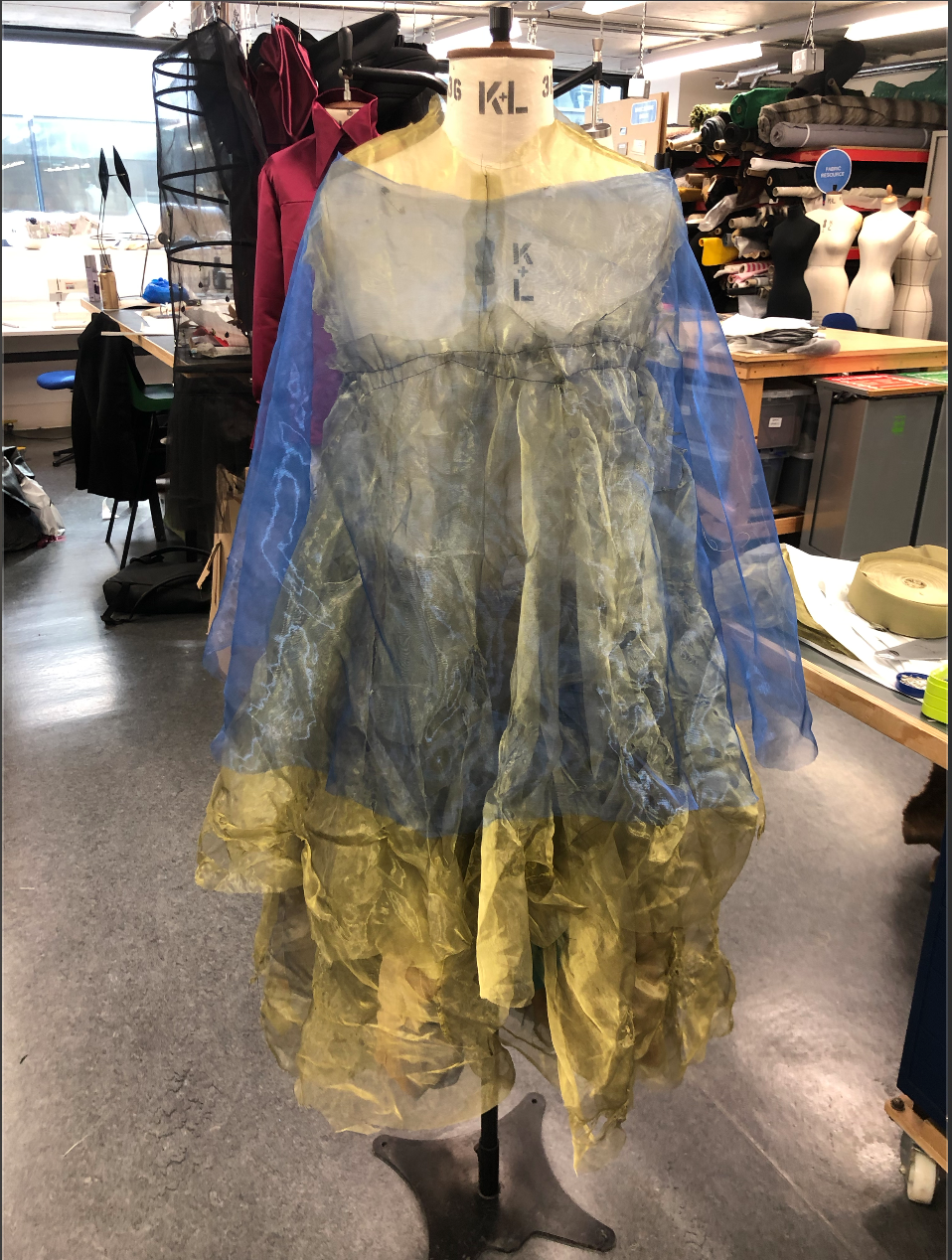
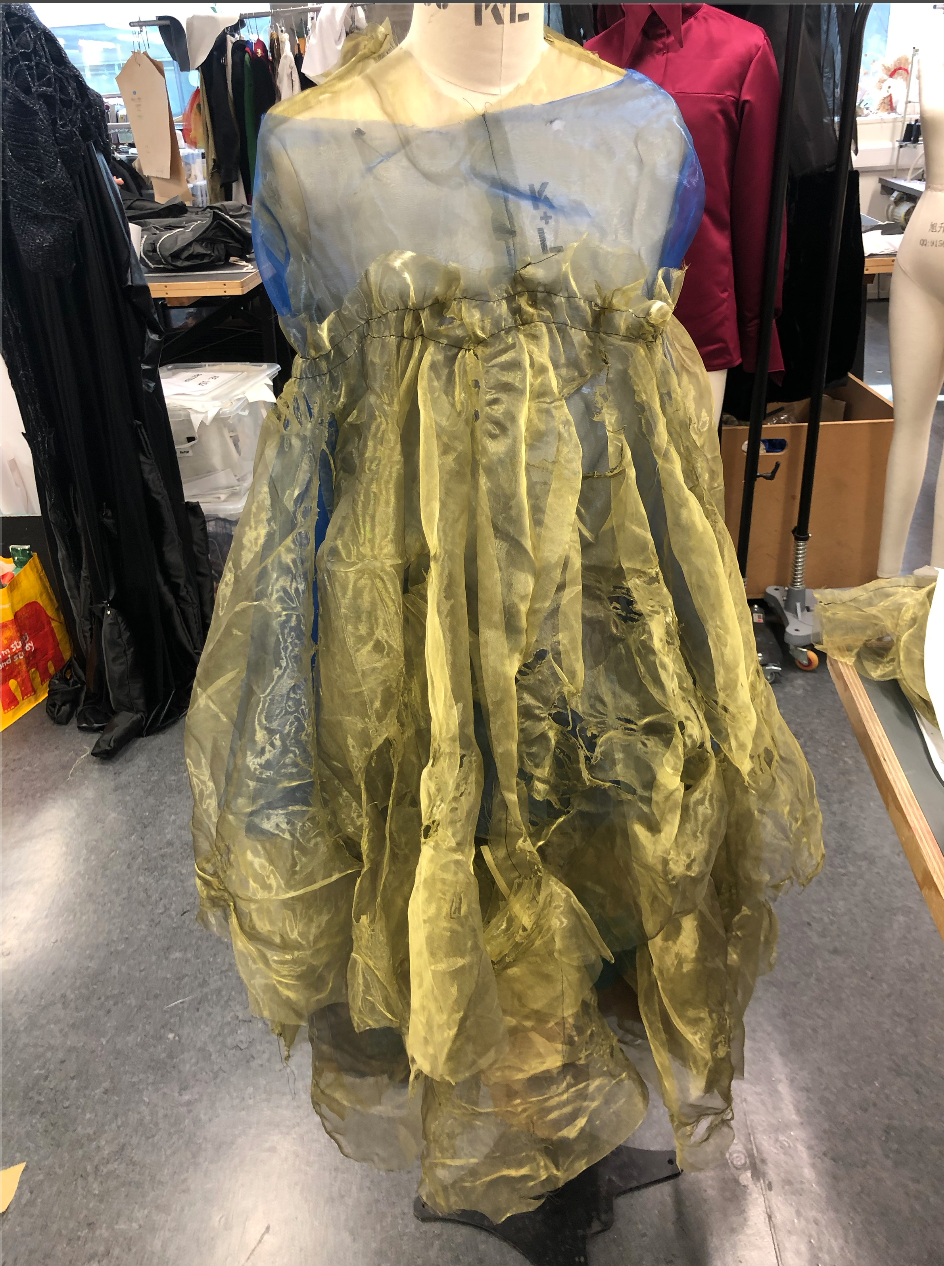
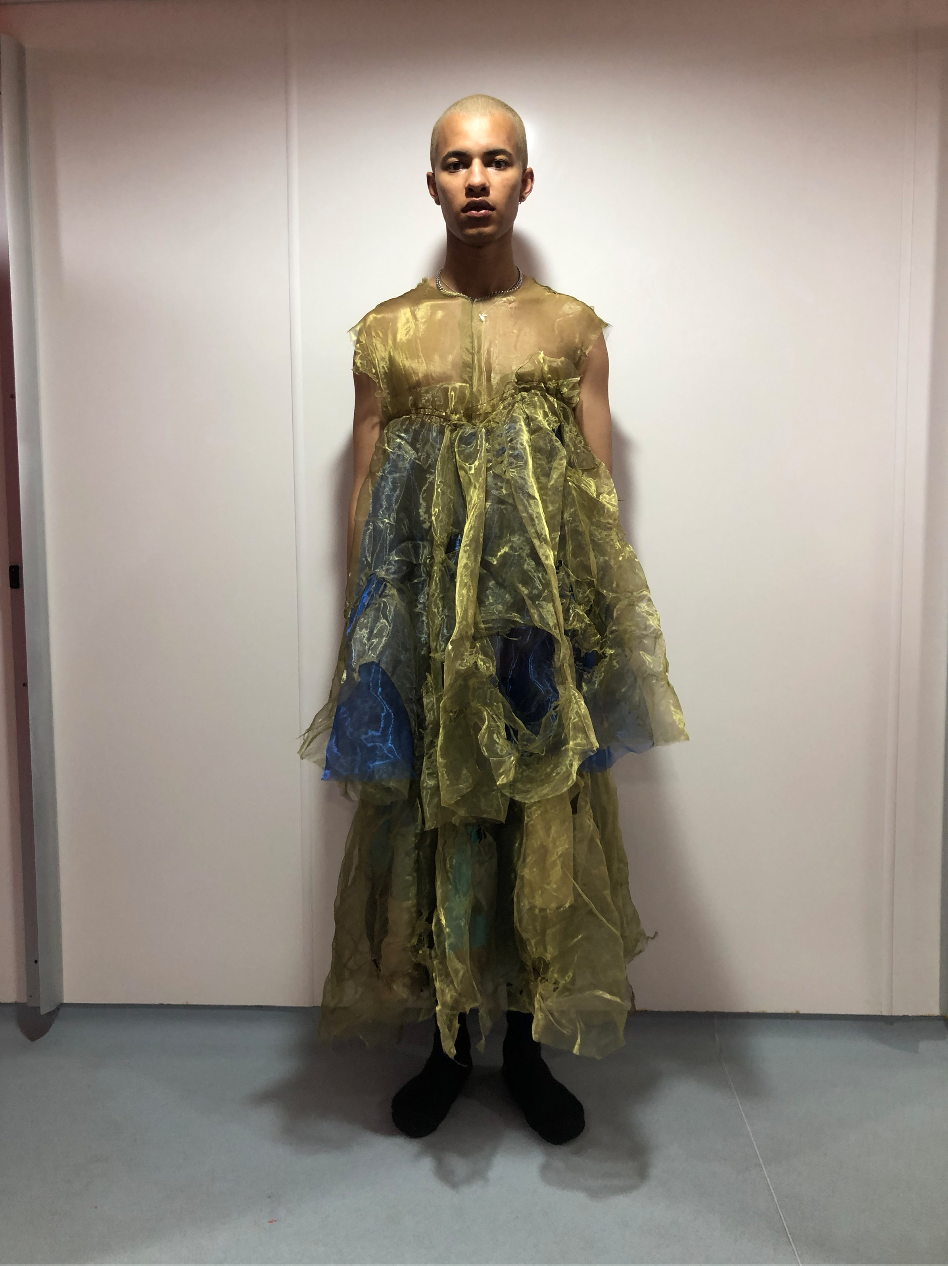
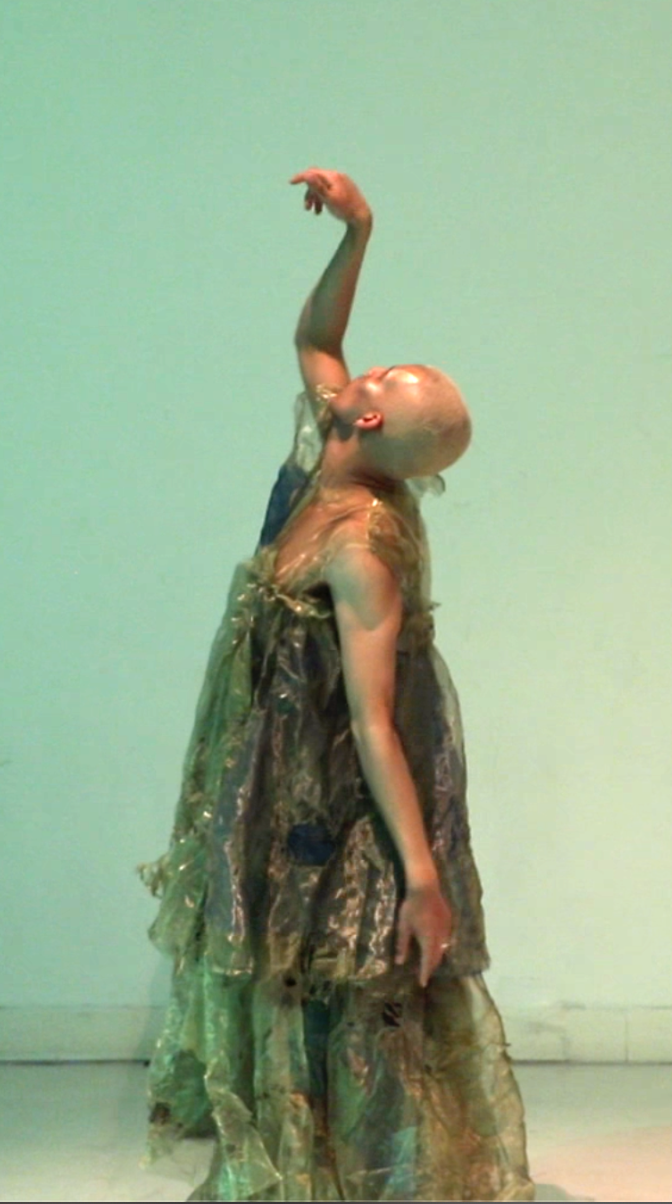
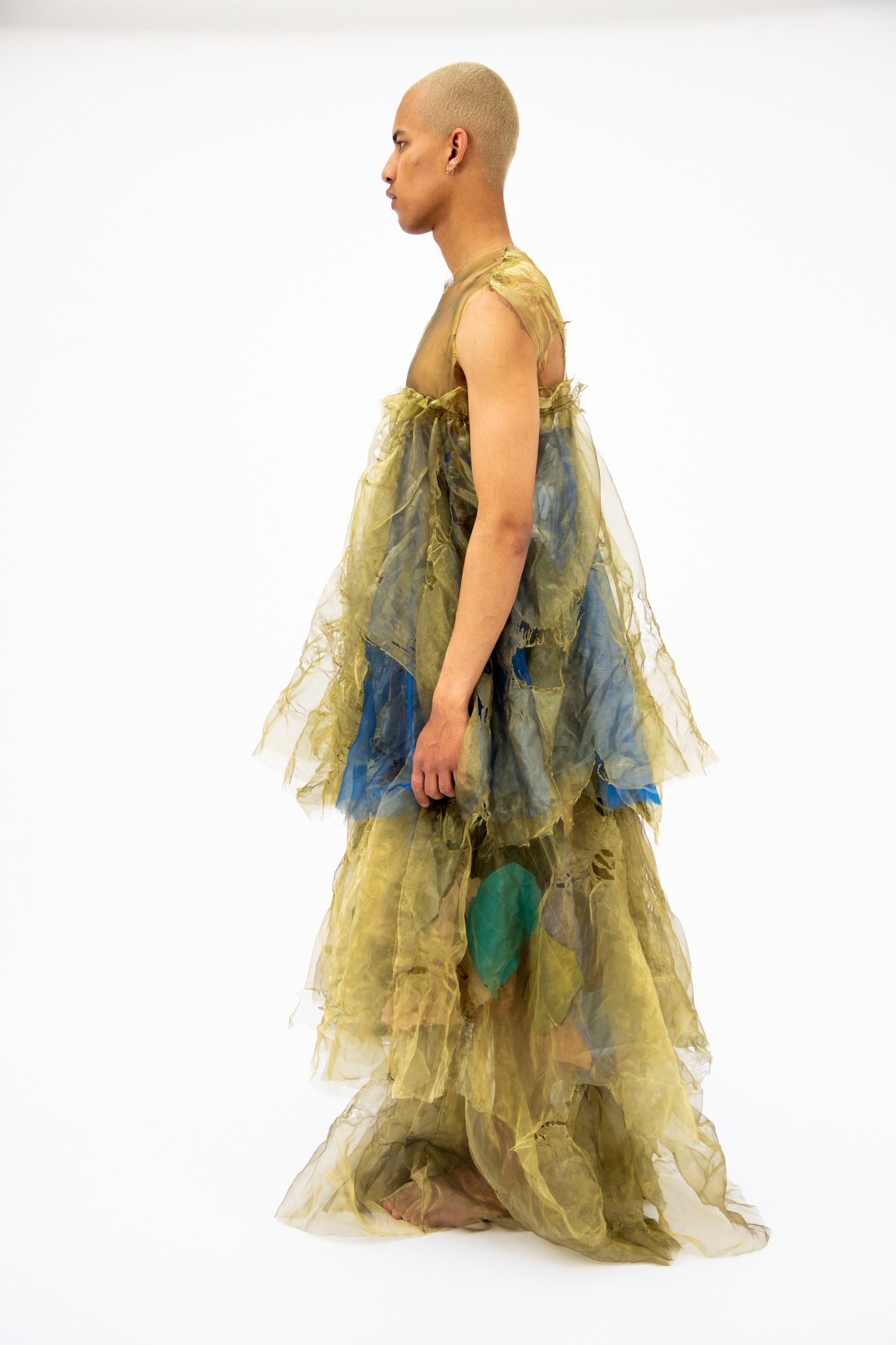
REGROWTH: Organza Circle Skirt Layering Tests ︎︎︎ Fitting ︎︎︎ Rehearsal ︎︎︎ Photoshoot
SET & PROJECTION:

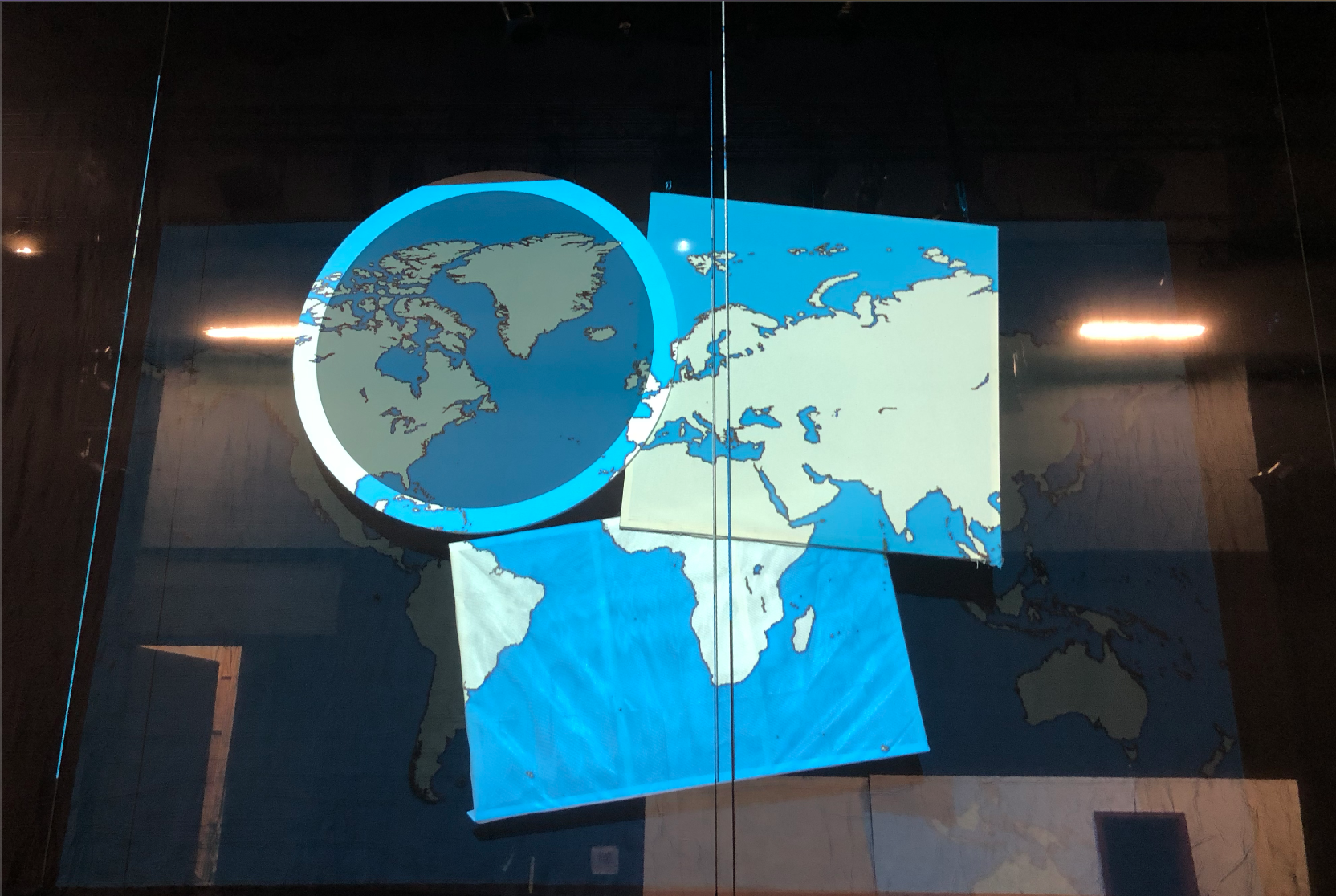
Testing lighting, Playing with Silhouettes, Projection Mapping & Blocking
I learned a new programming technique called MIDI cues to patch between Q-lab and Isadora so when Kristina operated the sound it would automatically trigger the projections in Isadora. This saved us a lot of time and made the programming process collaborative.
PROGRAMMING:
STORYBOARD:



EXAMPLE OF MY ISADORA PROGRAMMING: This process was trial & error because we did not have a tech rehearsal prior to the filming day. A lot was fixed on the go during the filming day which meant I had to be quick to catch errors and trusting my collaboraters in their respective roles on the day while I dealt with the programming.

LOGISTICS
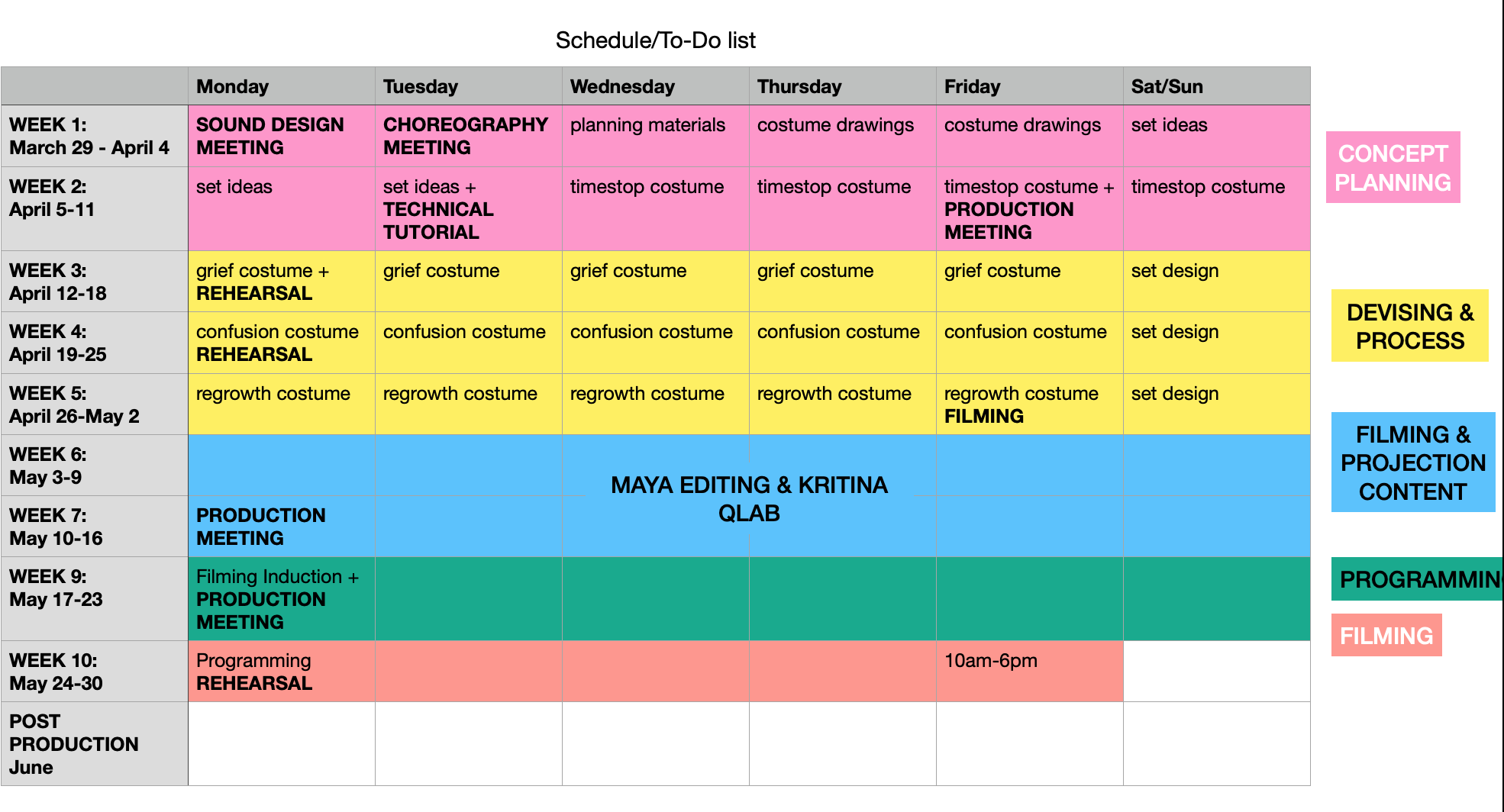


making process schedule budget breakdown, filming day schedule.
NEXT: OUTCOME ︎︎︎
OUTCOME
Full Performance (Duration: 10 mins)


The final outcome was such an evolution from where it started. I have to admit that throughout the process, sometimes I got a bit blinded by the design of it all. I think for a while that I was so focused on the initial research and so intent on having technical elements and a set build and sometimes ignored what the piece actually needed: a sensory and visceral experience. This project taught me that less is more. More specifically, I learned that successful and effective design is a visual dramaturgy, not a technical show-off. When I think back, I was pushing for things such as the kinetic sculpture for the wrong reasons. While I did want to challenge my skills, there were better avenues for that such as the projection being a merge of the physical & digital spaces I have spent the year exploring in Unit 9 and Unit 8. In conclusion, by simplifying and cleaning up the different elements of our collective ideas, we were able to create something that layered to create the complexity. I think that was my most fruitful bit of learning throughout the whole year.
Secondly, this project was a true test in terms of collaboration. Luckily, my previous projects, such as the Opera Design, taught me about remote collaboration. However, this was on another level because it was our dramaturg, Maya, who was abroad. I believe that this greatly improved my ability to communicate ideas and benefitted the outcome in the end. One of my flaws in this development was that I was stubborn and only wanted to think of this as a live performance. So, it was vital that I had a collaborator who could see this from the position of an audience member and reel me back in when I strayed from the reality that this was a recorded performance.
Another critical moment in this collaboration was working with Zac, who is a movement artist and filmmaker. Especially with the filming of the video designs, e was able to take charge where my filmmaking skills fall short. I think another element of successful collaboration was that I was continuously learning from my peers. This allowed me to facilitate a flat hierarchy because we all had our own strengths and I got better at delegating tasks. This allowed us to be ahead of schedule, but also to feel like everyone got an equal creative input. As the project developped, we kind of all became the dramaturgs from our respective specialisms. While Maya and I had developped the concept together, I really wanted to make sure that Zac & Kristina were able to bring in their own experiences and had the freedom to lead the piece in a specific direction when it was appropriate. For example, Kristina ended up leading most of the narrative structure decisions based on how she was composing, and the sound became the cue for everything else: choreography, video, and projection. While I can reflect and say that I was the Lead Artist, if I had to, I believe that this was an equal collaboration. And thus, I achieved my goal.
© Jida Akil 2025